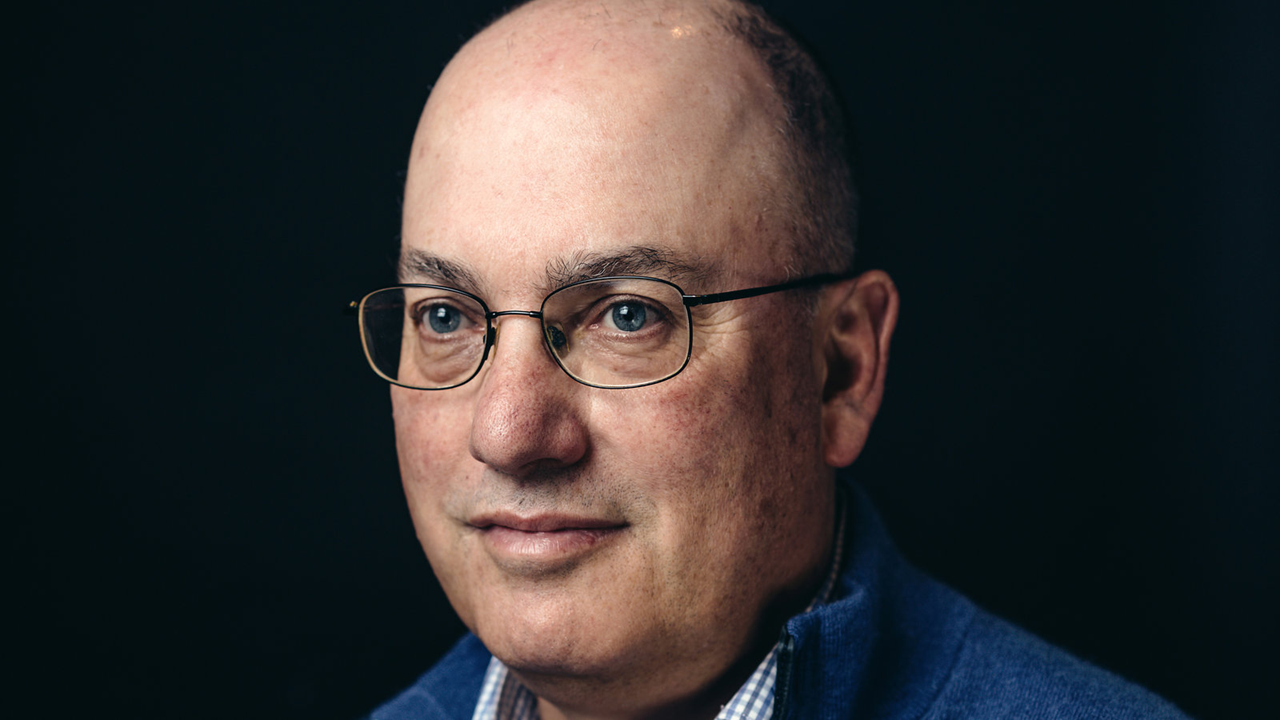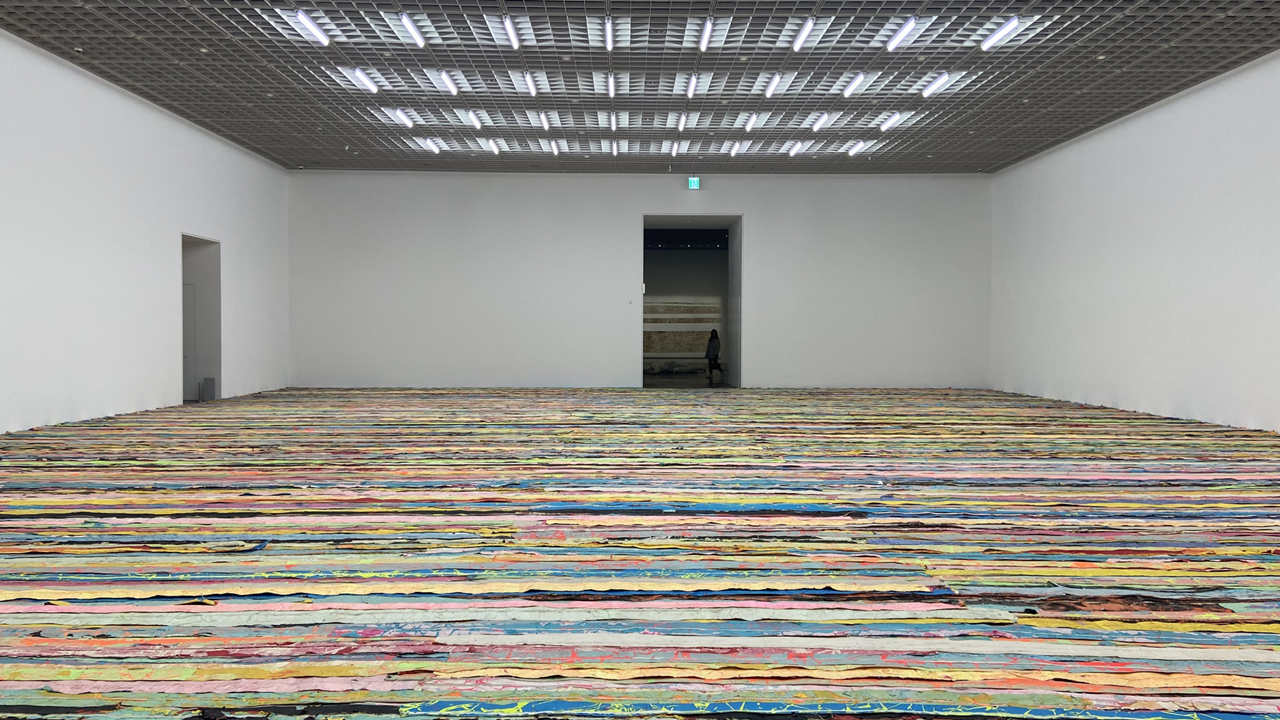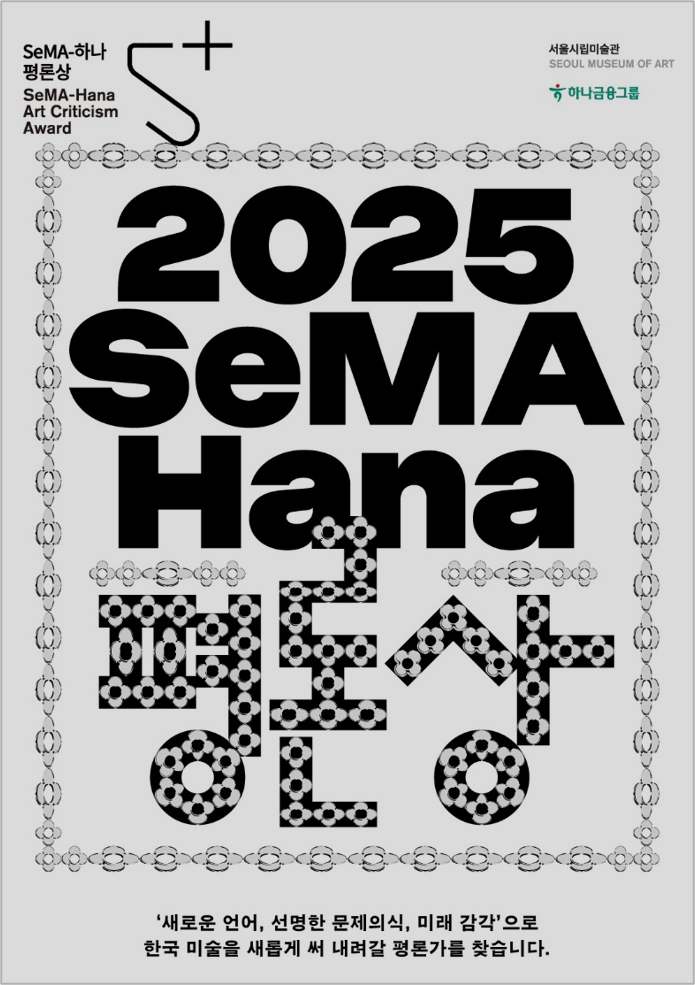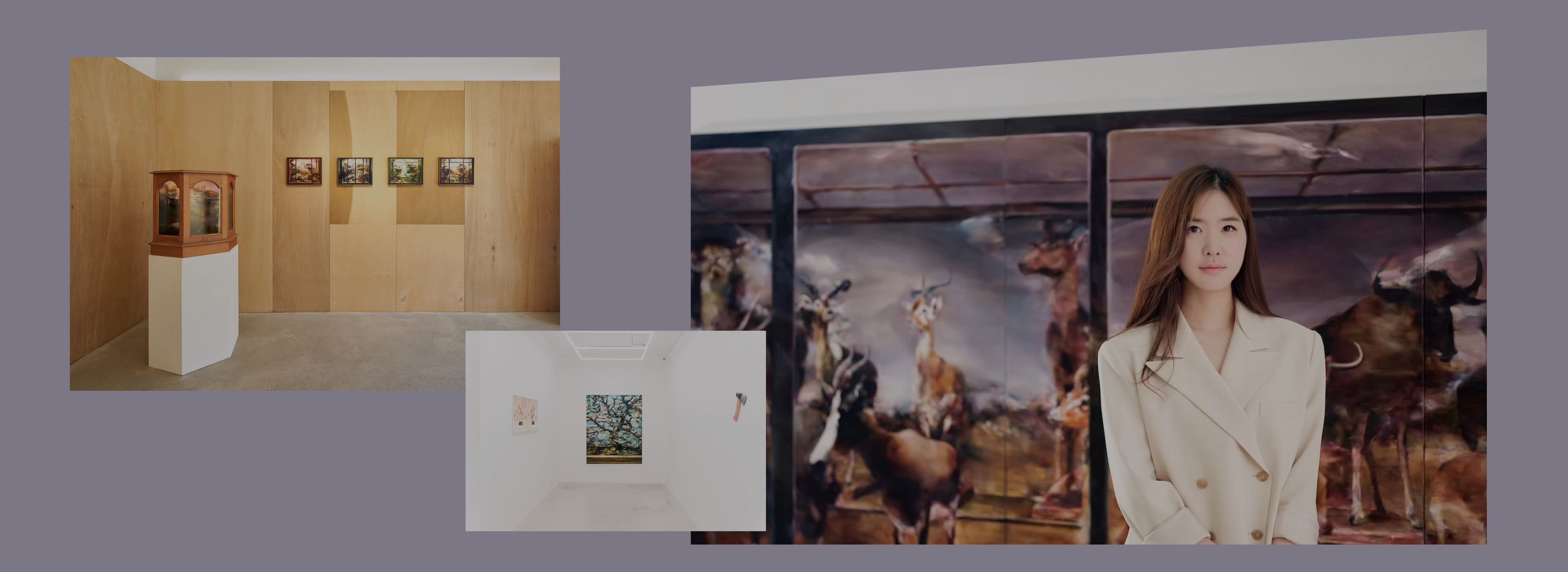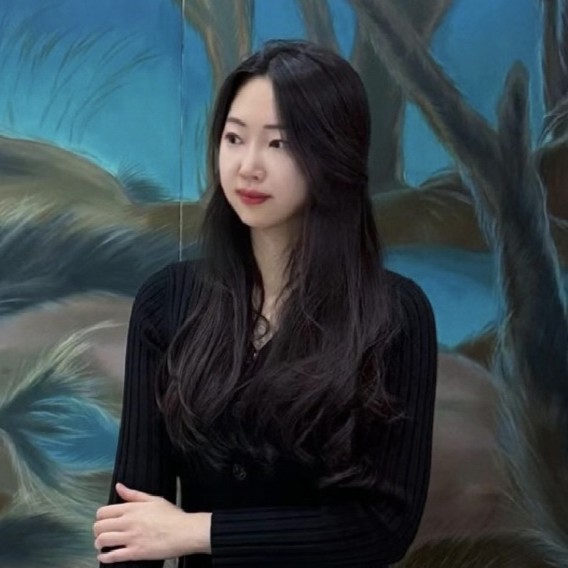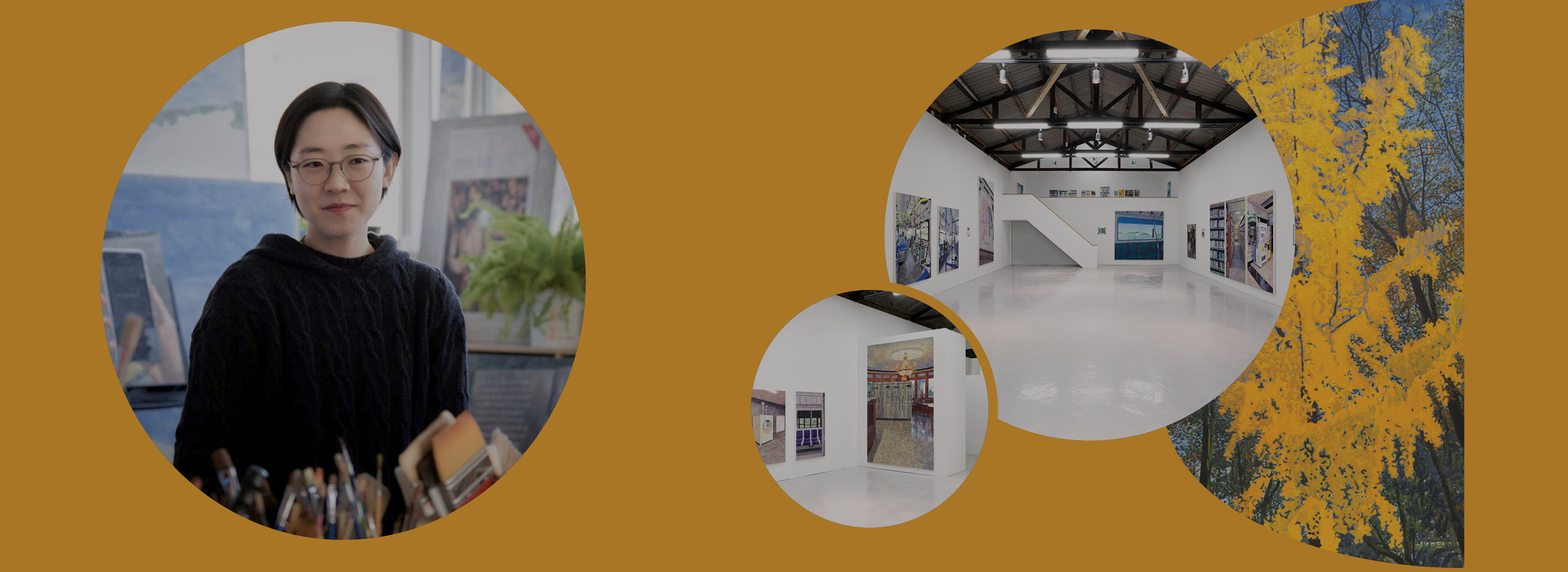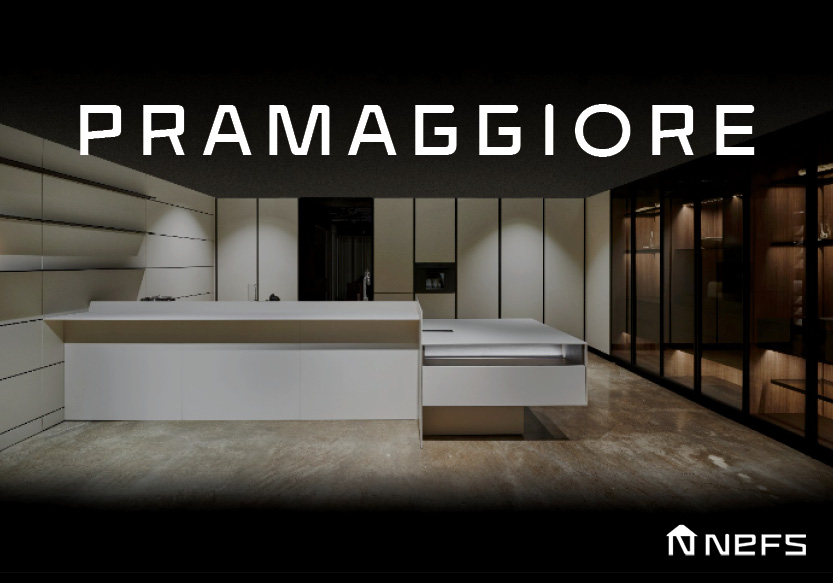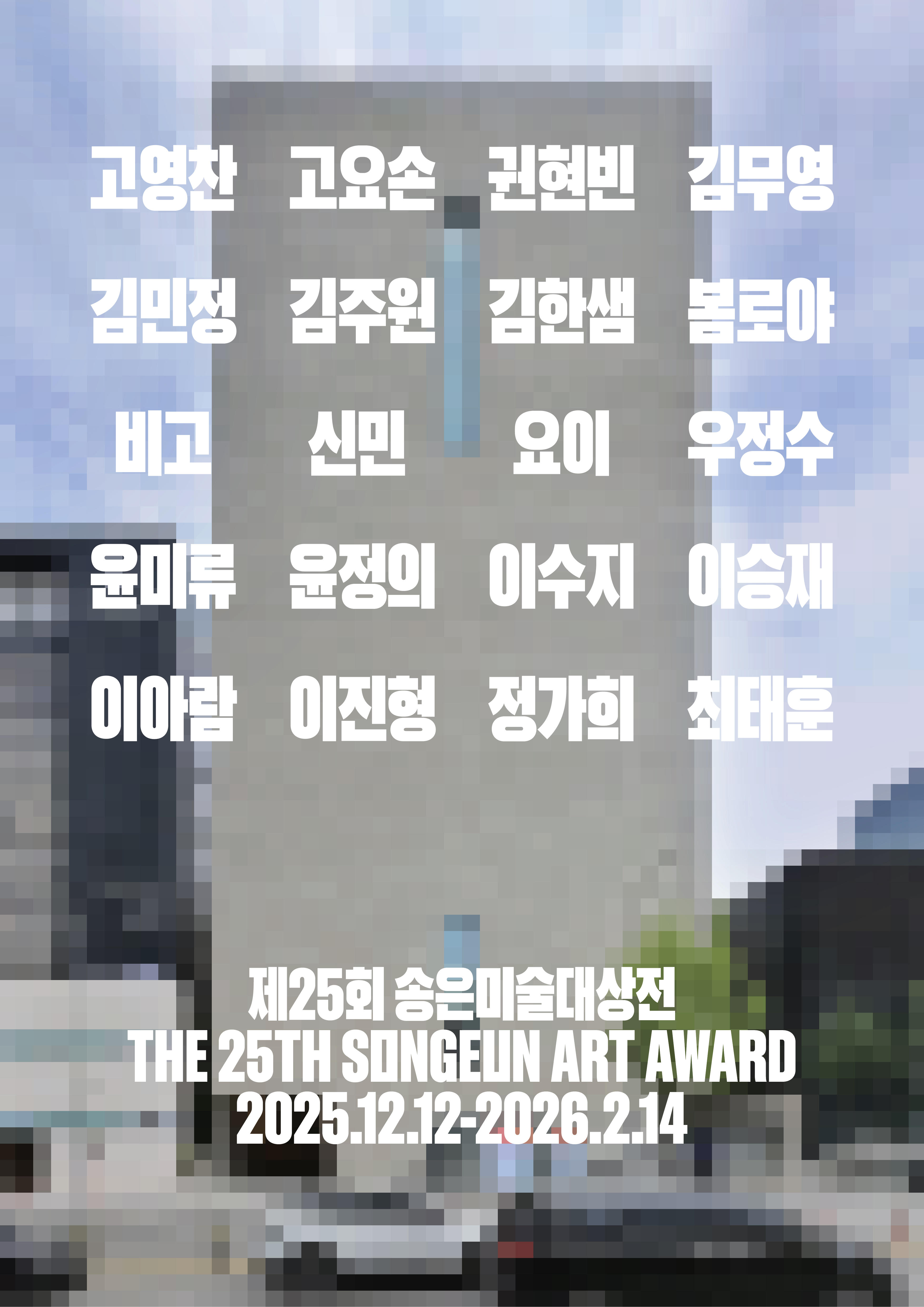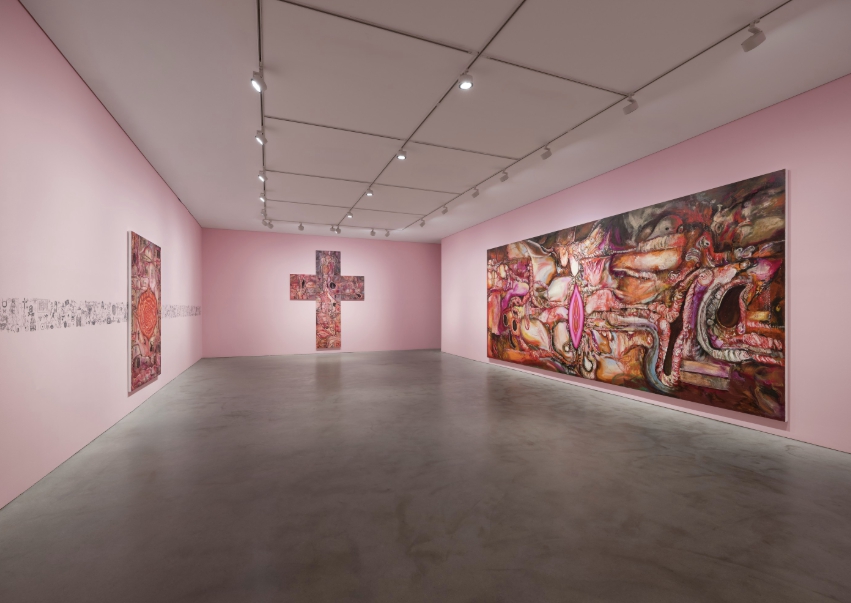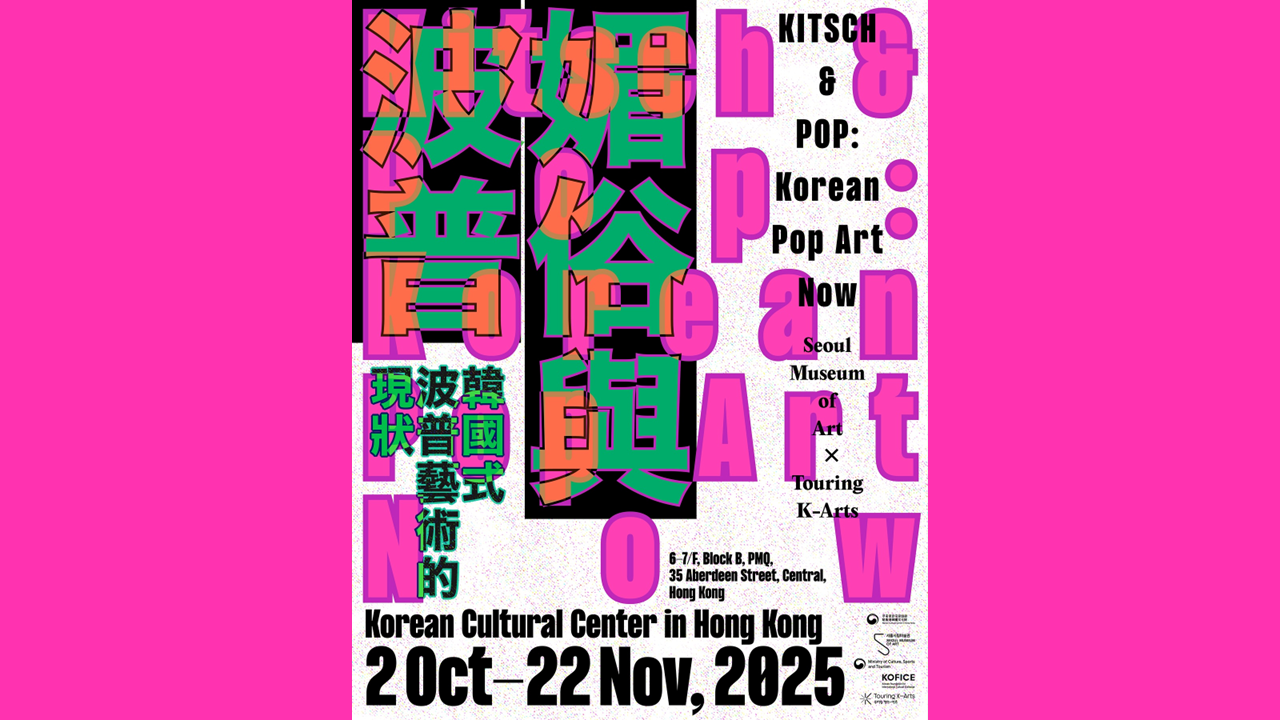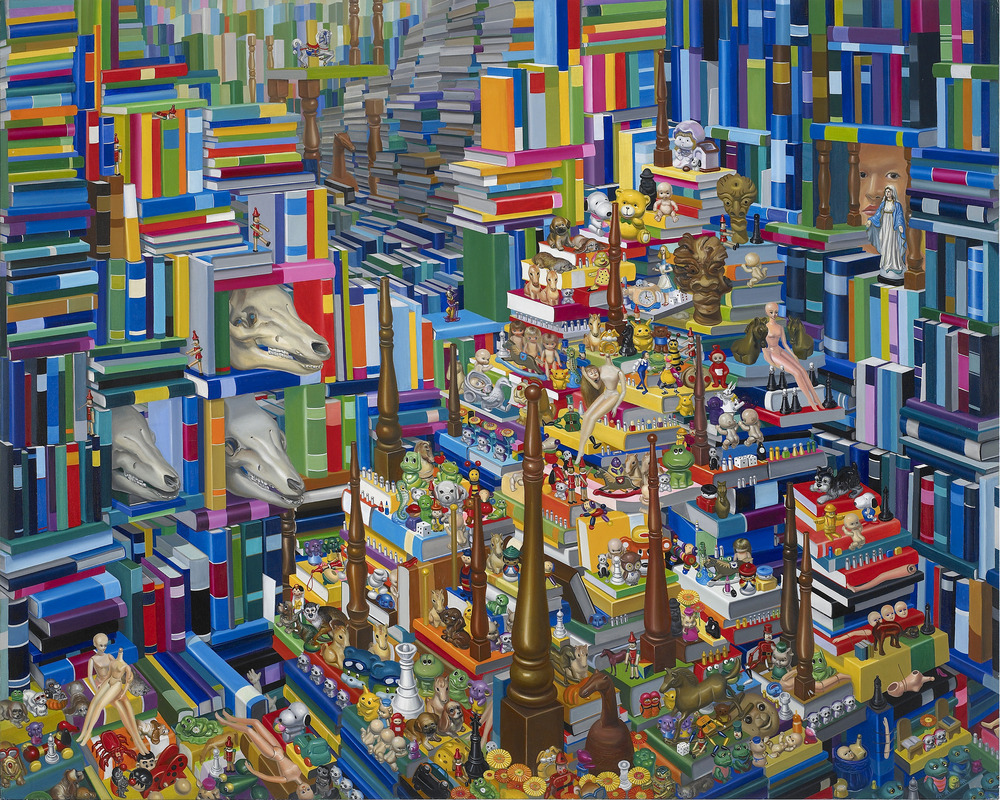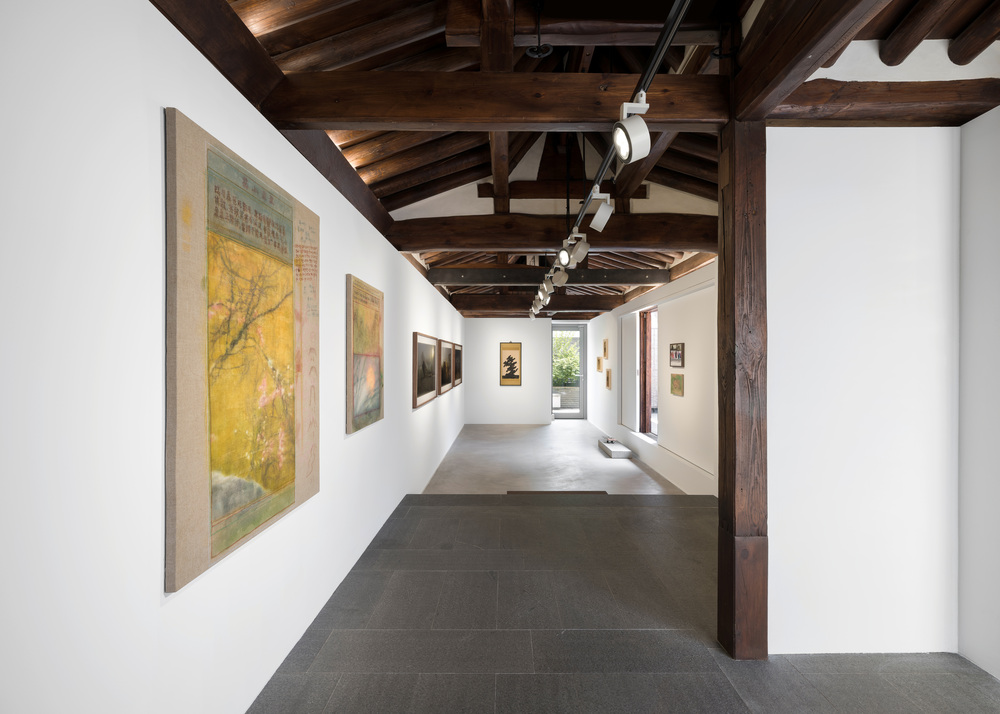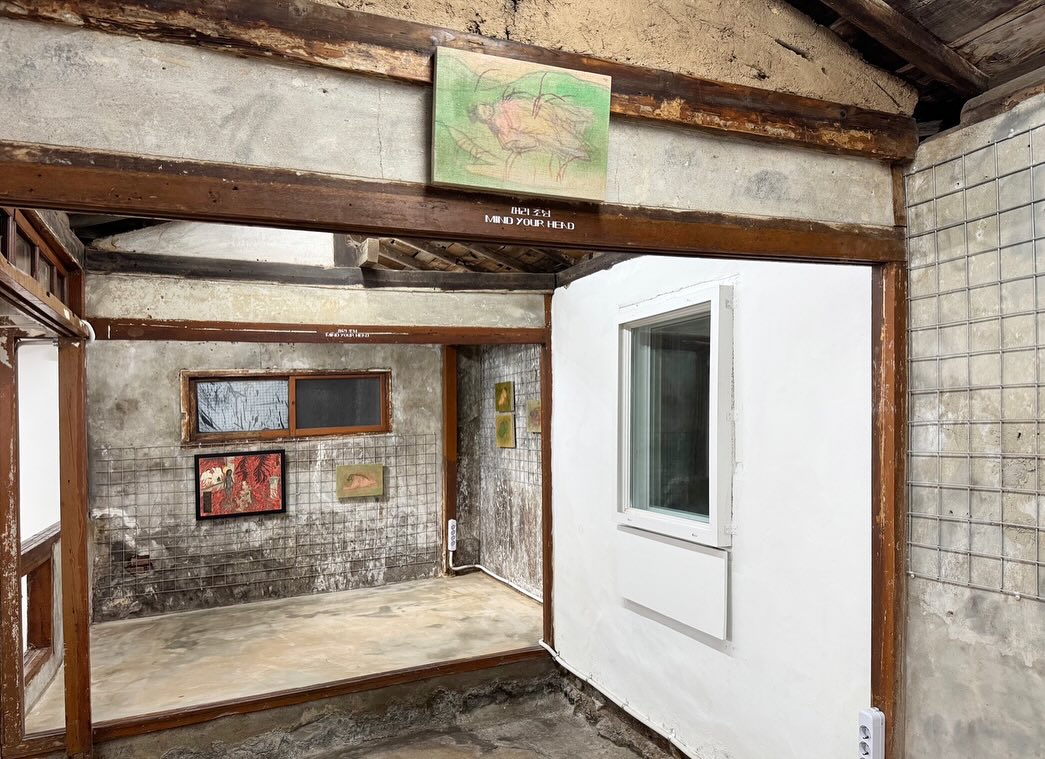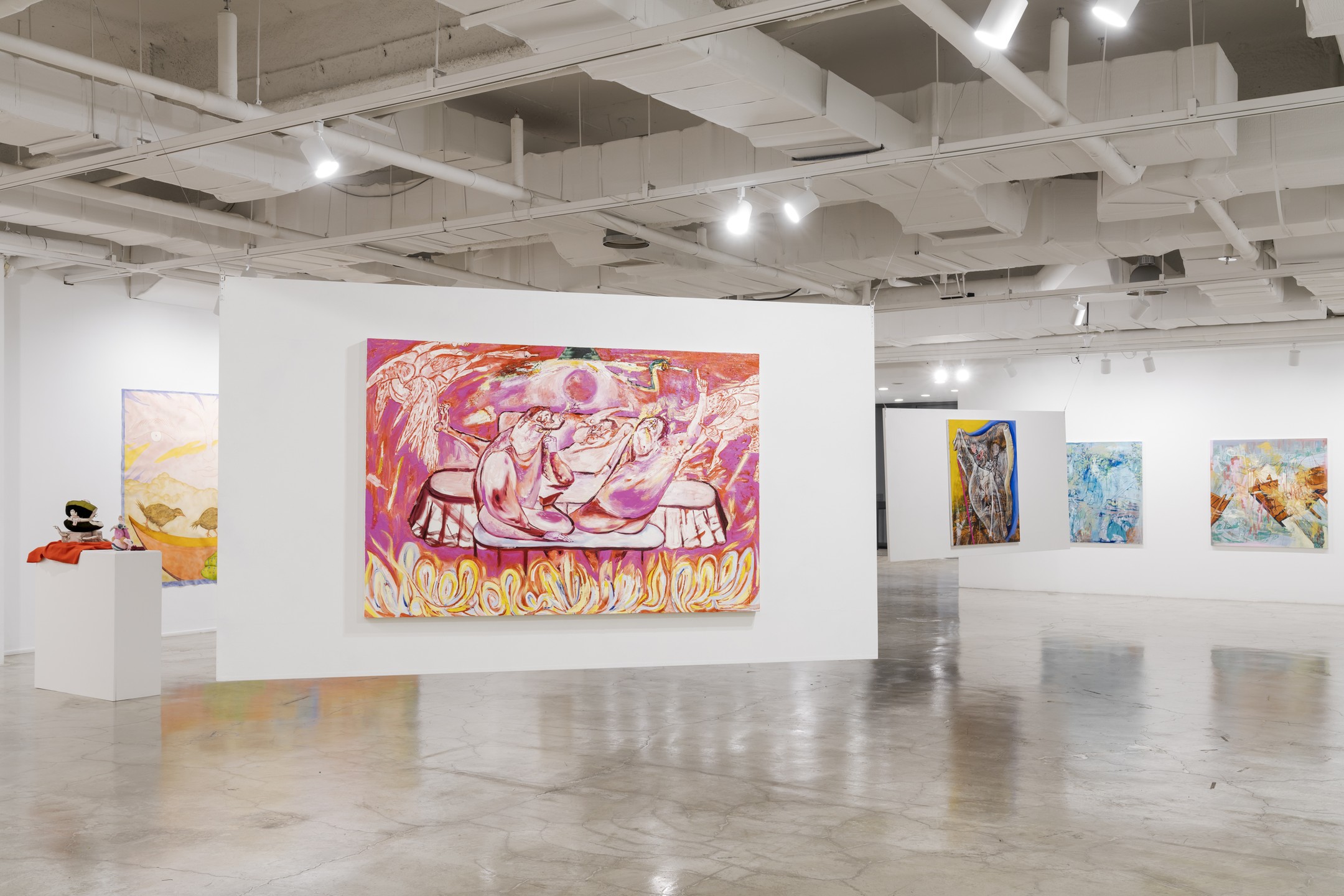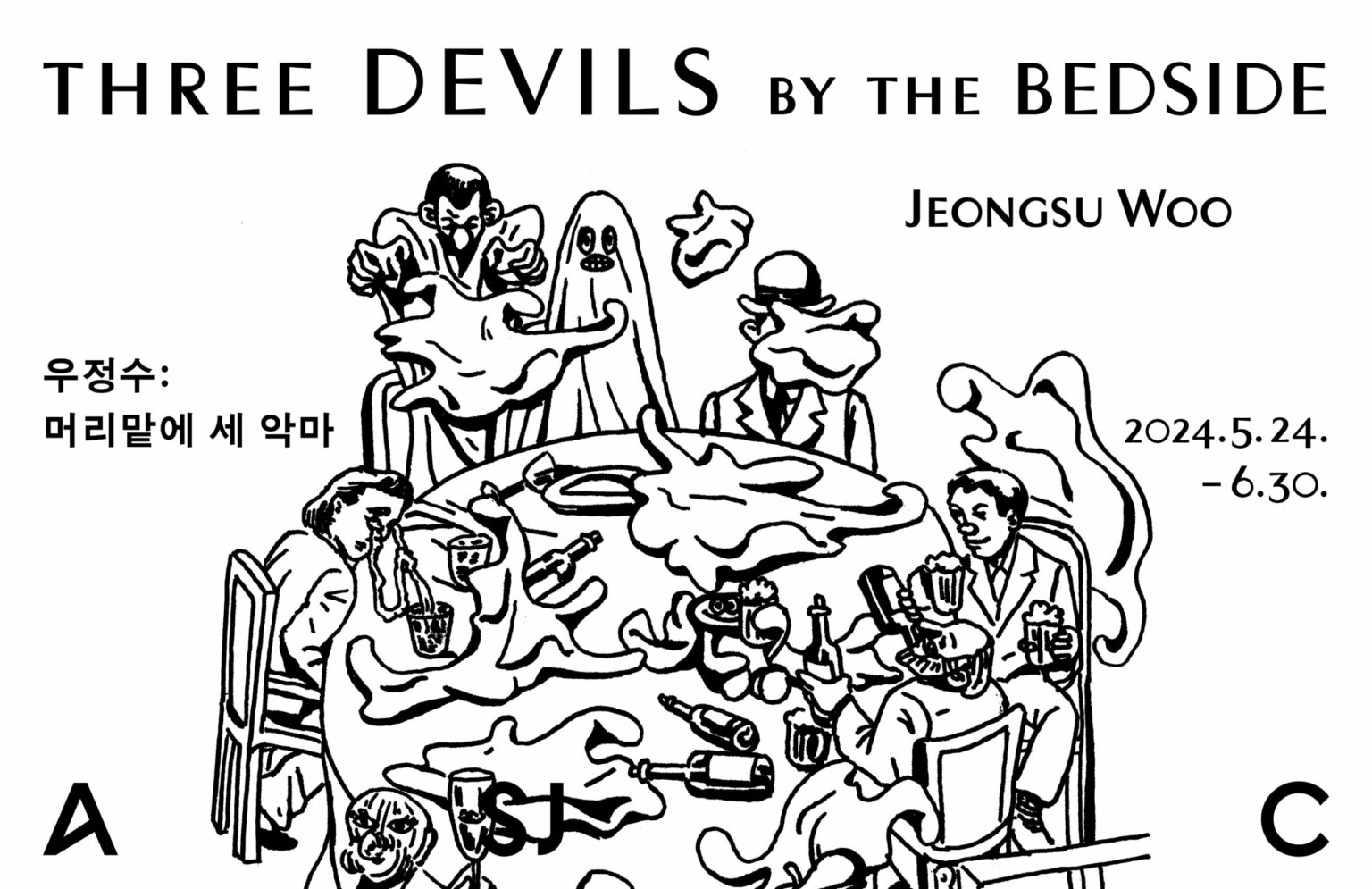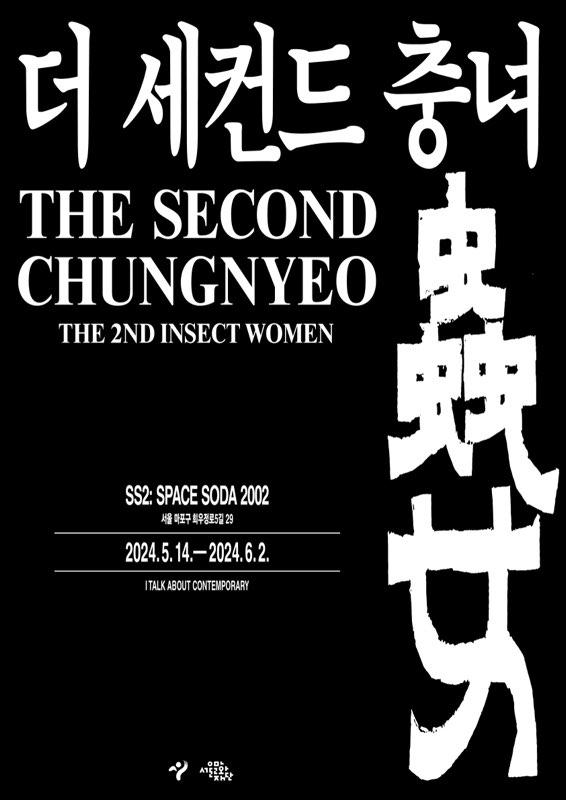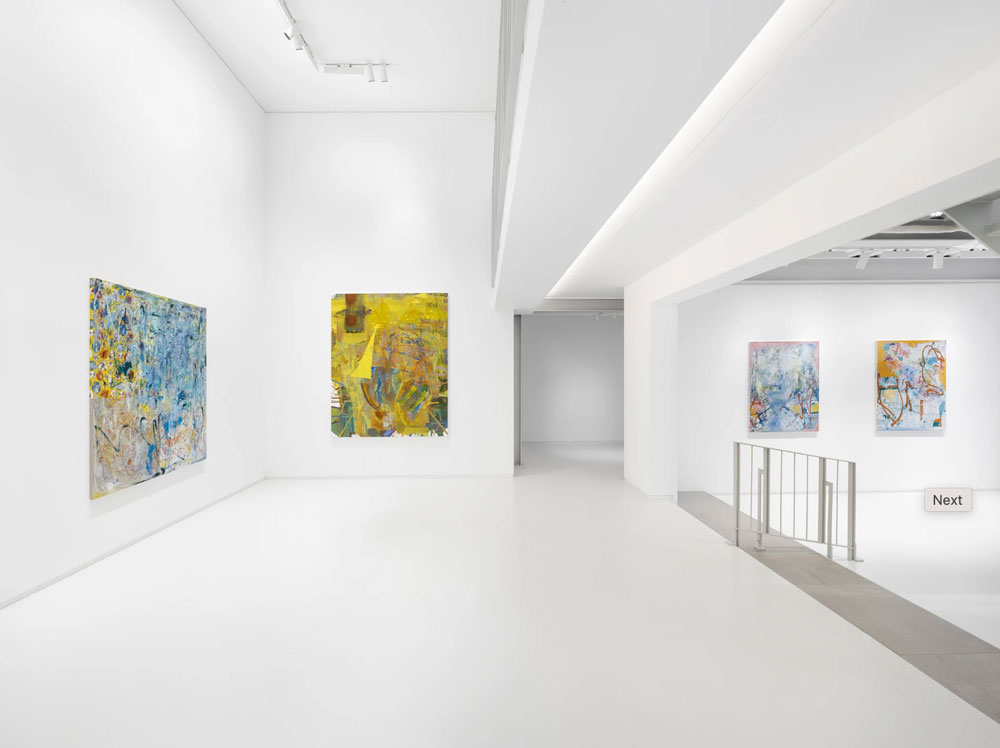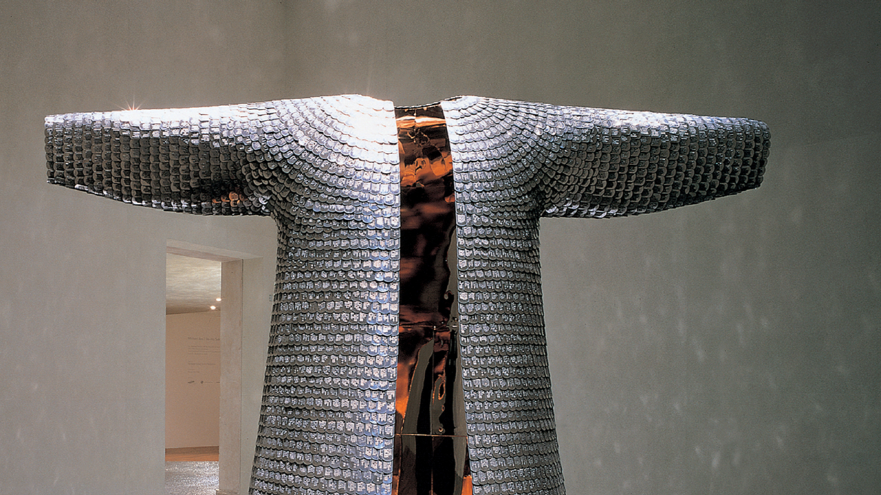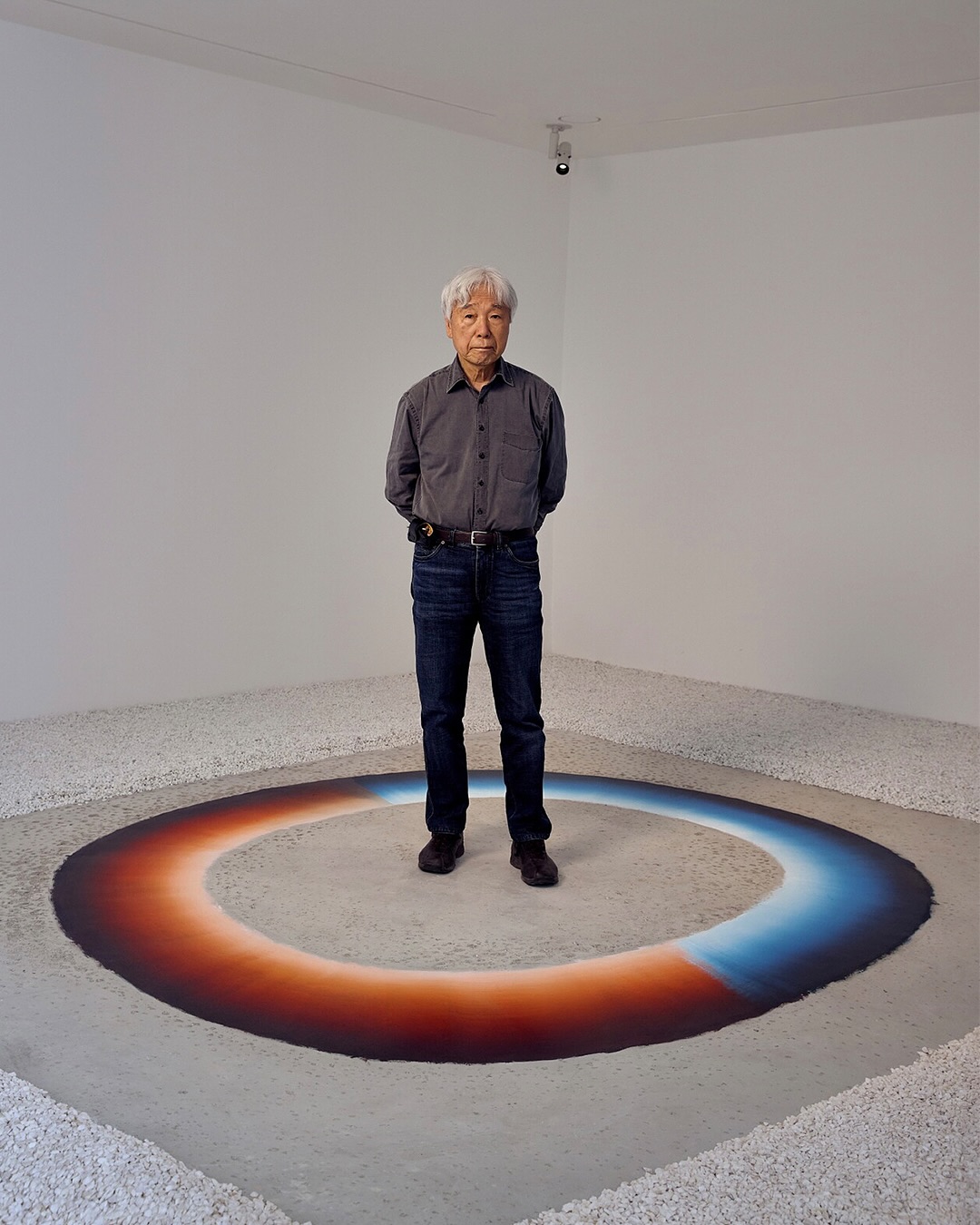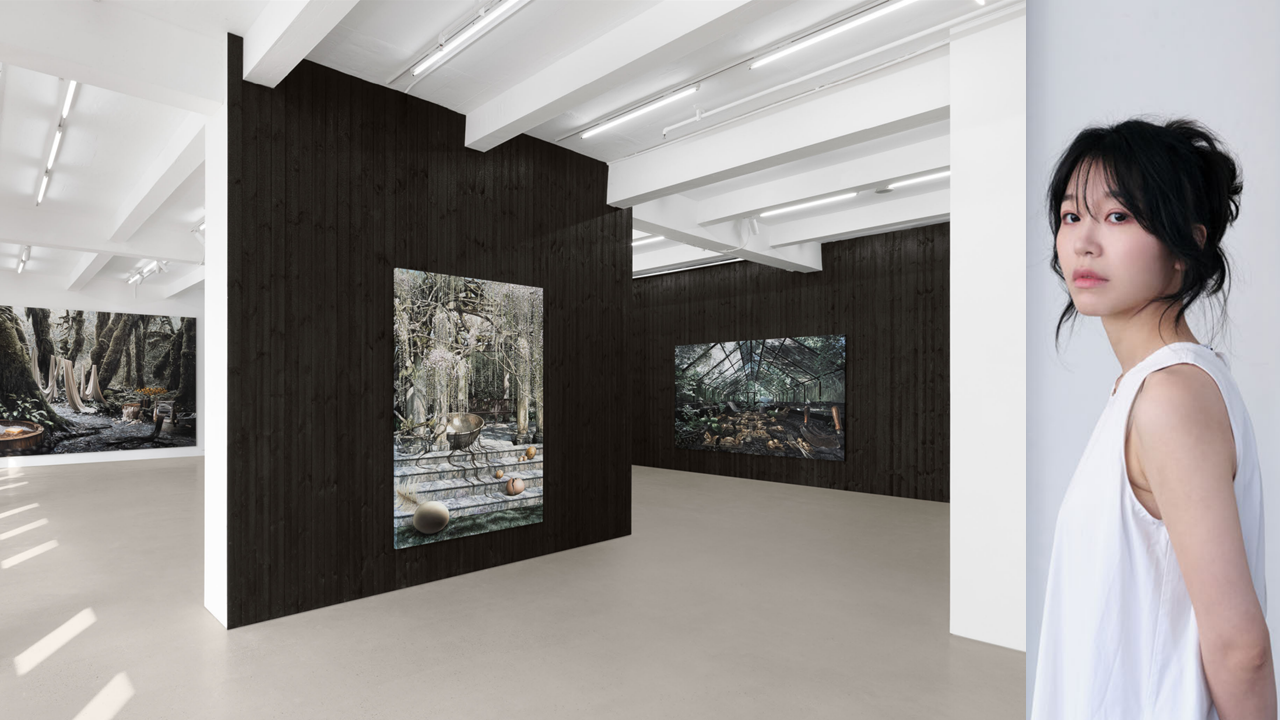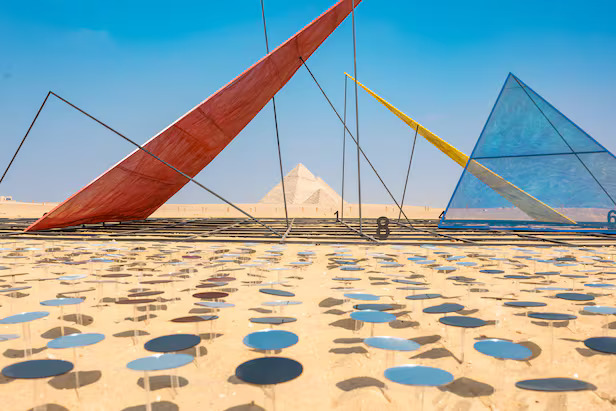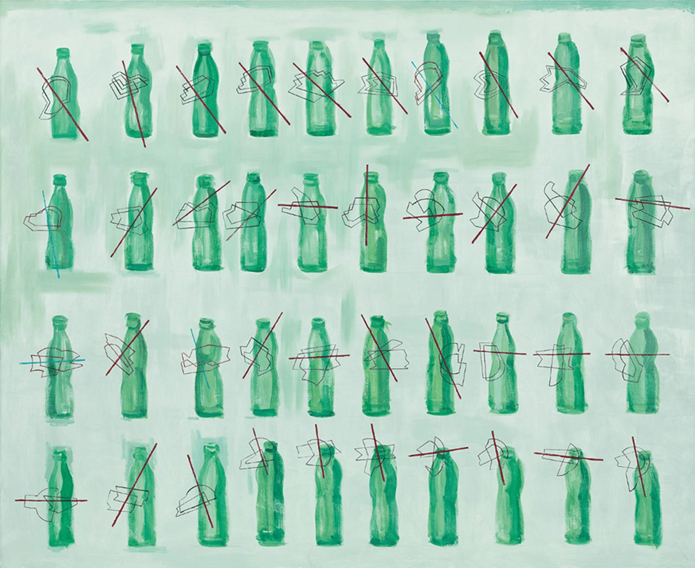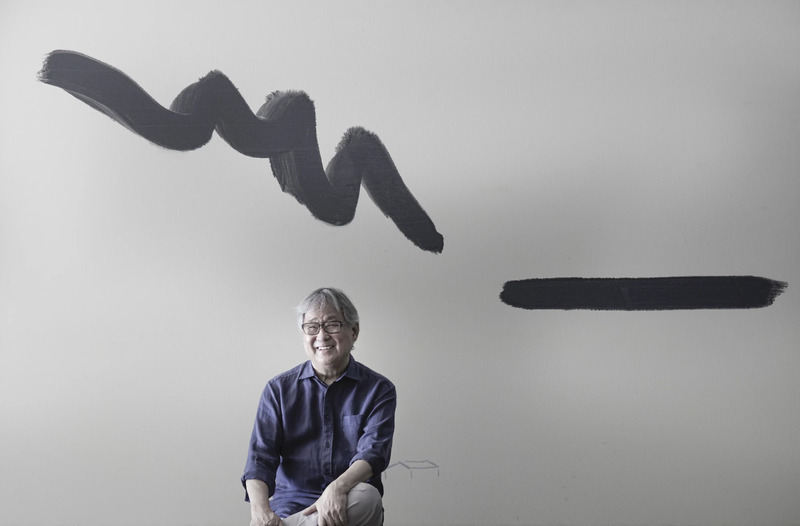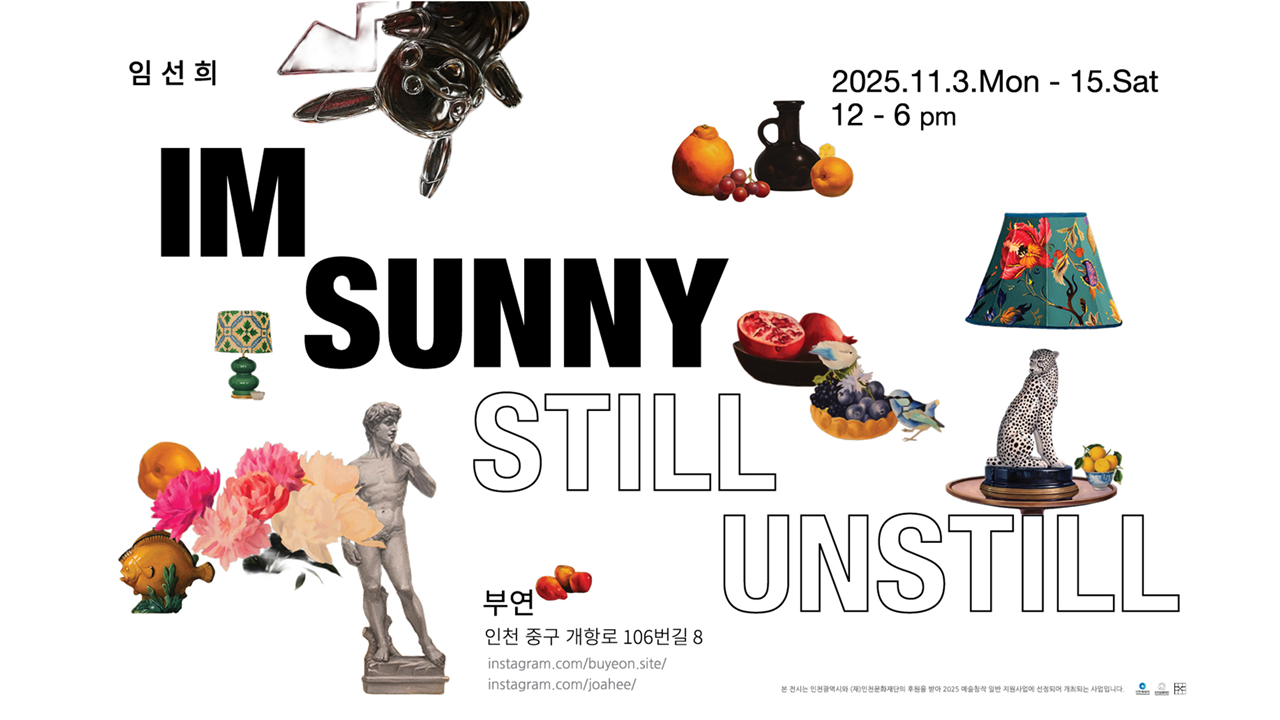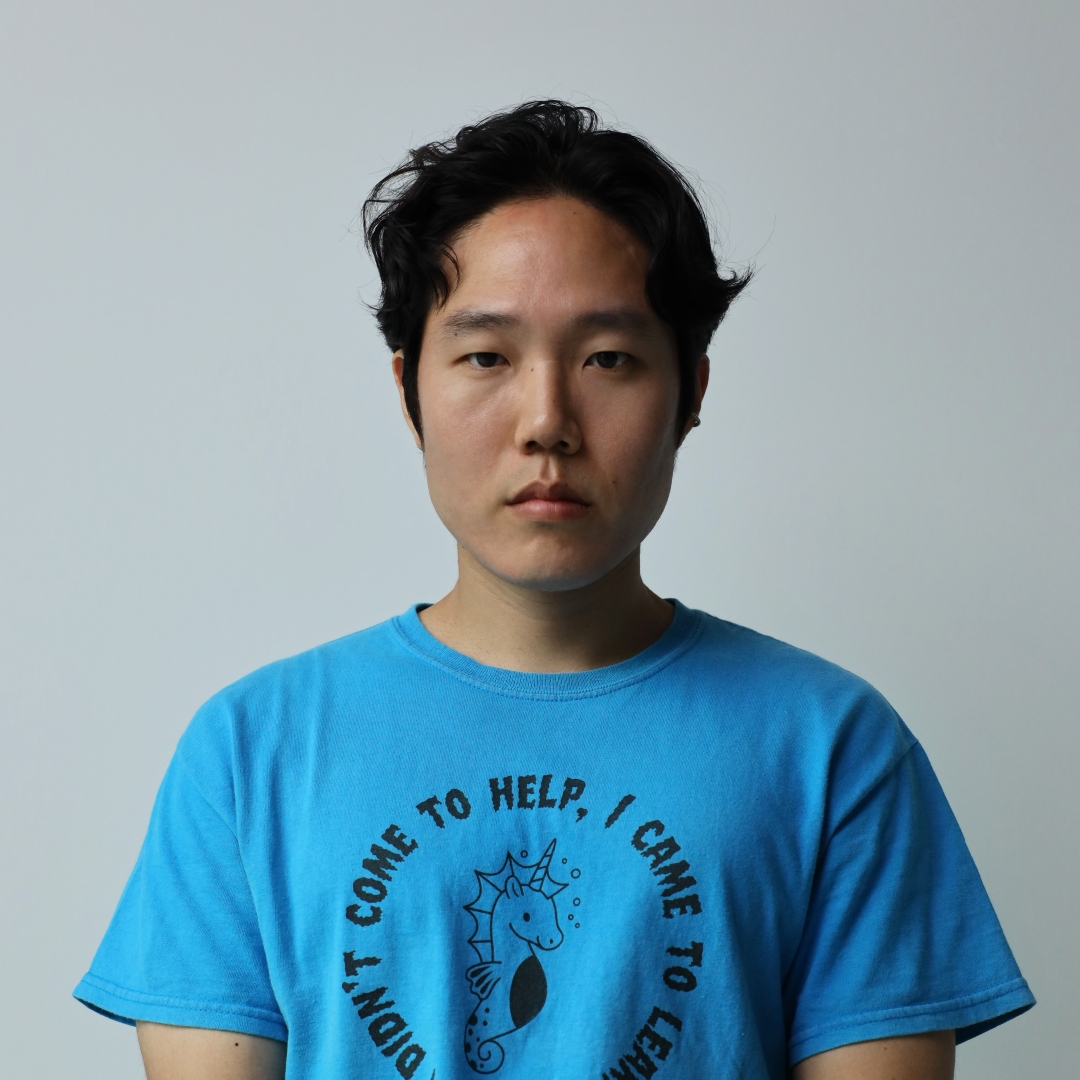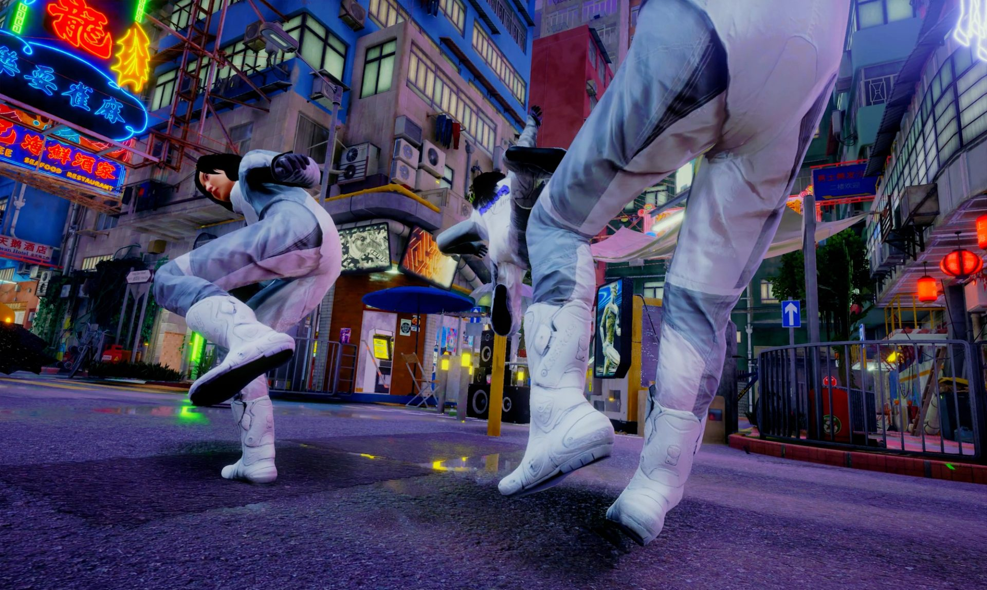Jeongsu Woo
(b. 1986) creates new narratives by drawing inspiration from a wide range of
visual imagery and storytelling traditions, spanning from medieval European
illustrations and art-historical iconography to popular novels, comic book
characters, and contemporary subcultures such as Goth.
By
deconstructing the contexts and narratives of these elements and reconfiguring
them into contemporary stories, he explores the potential for a new form of
allegorical painting in the present era.
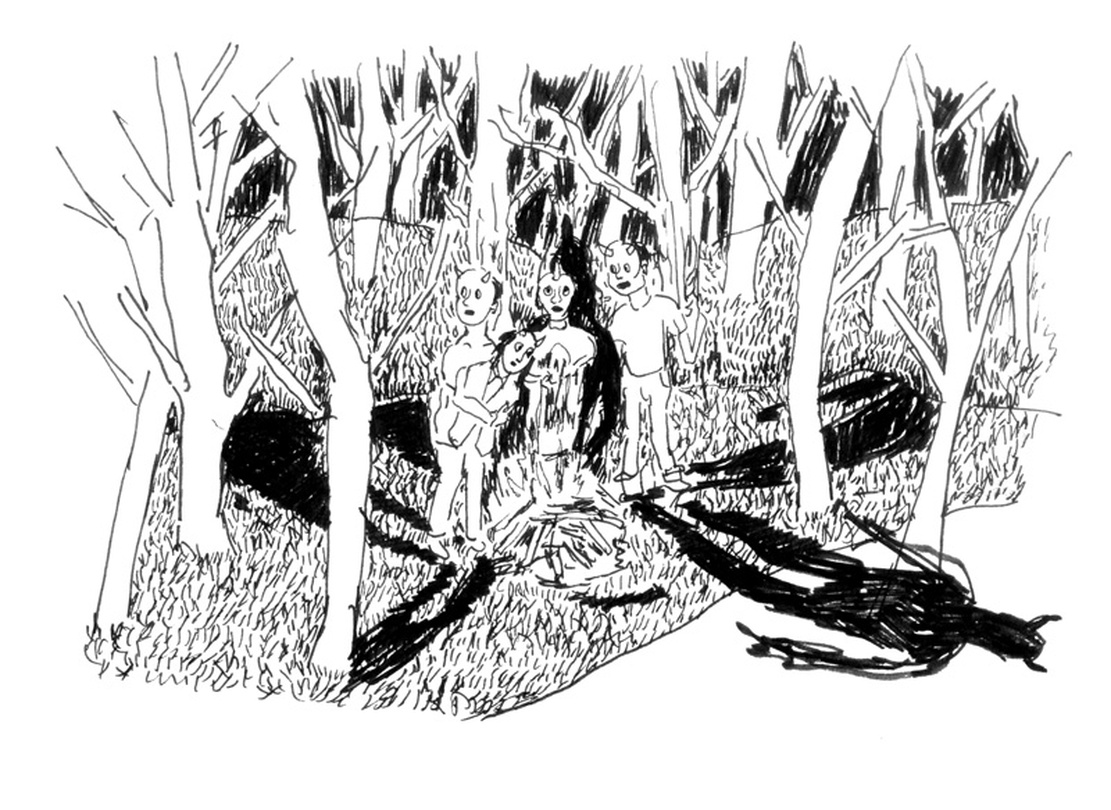 Jeongsu Woo, Goblins’
Forest, 2011 ©Jeongsu Woo
Jeongsu Woo, Goblins’
Forest, 2011 ©Jeongsu WooIn the early stages of his practice,
Jeongsu Woo produced numerous black-and-white pen drawing series. Beginning in
2010, he created the ‘Flâneur Note’ series, a collection of drawings made
solely through the tactile sensations of his hand. Rather than following any
predetermined logical rules, these drawings were executed instinctively and
without hesitation, forming a loosely connected web of symbols.
As suggested by the term “flâneur,” this
work reflects Woo’s perspective and attitude as both an individual and a member
of contemporary society—observing and contemplating the world around him. For
nearly a decade, he positioned himself as an observer, capturing moments of
compliance and resistance within rigid social systems, as well as the interplay
of faith and doubt in human existence. These observations materialized in his
works as satirical depictions of human and animal figures set against eerie, surreal
landscapes.
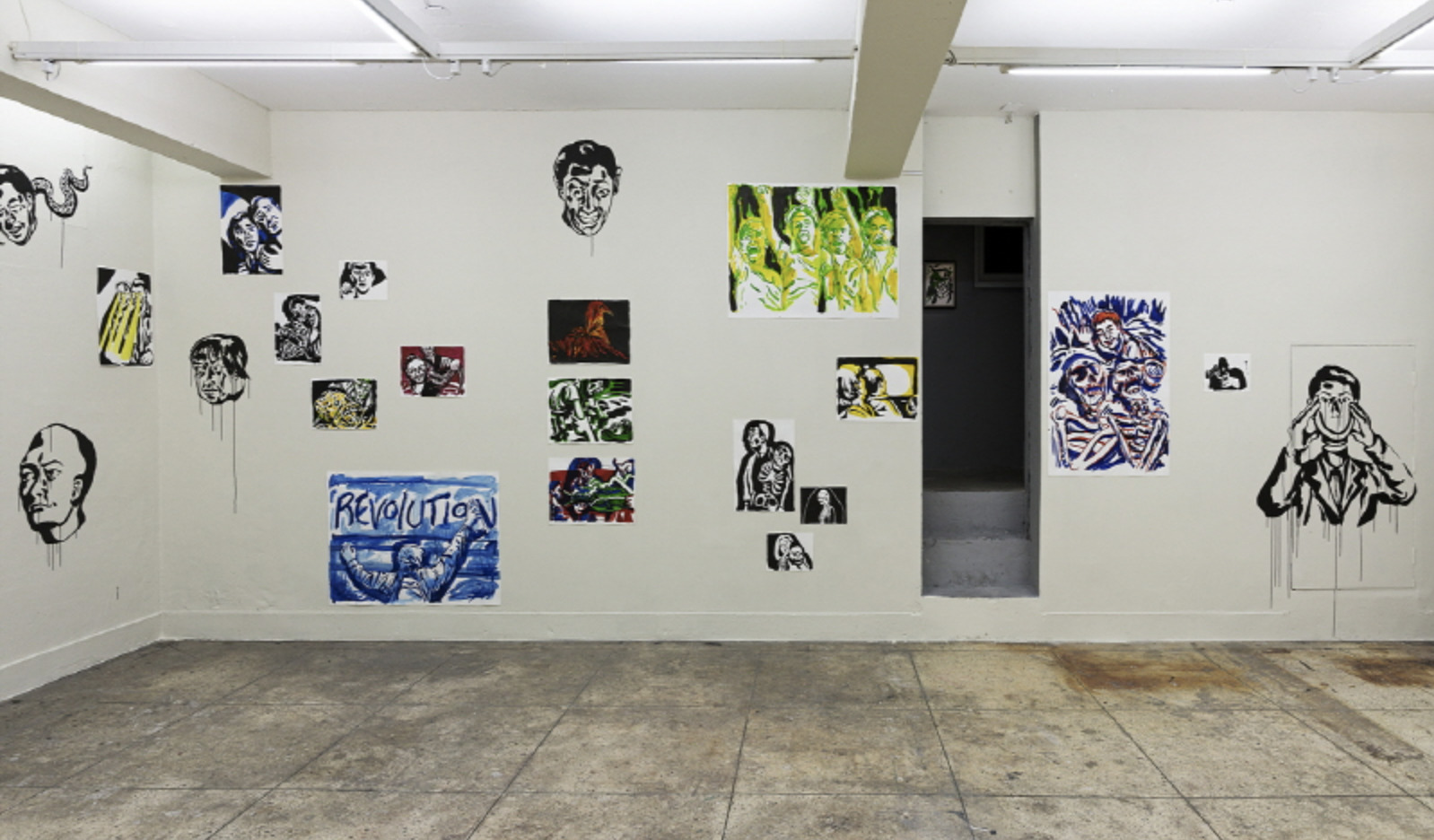 Installation view
of 《The Painting of Villain》 (Project Space
Sarubia, 2015) ©Project Space Sarubia
Installation view
of 《The Painting of Villain》 (Project Space
Sarubia, 2015) ©Project Space SarubiaJeongsu Woo has consistently maintained
this flâneur-like attitude, naturally contemplating how he should navigate life
as both an individual within society and as a painter. These reflections were
fully embodied in his first solo exhibition, 《The
Painting of Villain》, held in 2015 at Project Space
Sarubia.
In 《The Painting of
Villain》, Woo drew inspiration from the genre
aesthetics and sensibilities of film noir, which often portrays individuals
rebelling against societal structures to expose social contradictions. His
works featured monstrous and ghostly figures—familiar yet decontextualized—depicting
violent imagery that revealed the chaos and absurd realities hidden beneath the
surface of society.
Additionally, Woo transformed the
exhibition space itself into a dynamic canvas, boldly painting directly onto
the walls and integrating these works with his drawings on paper. Through this
organic interplay, he created a composition where countless unsettling and
fractured images triggered a chain reaction, amplifying a sense of instability
and rupture.
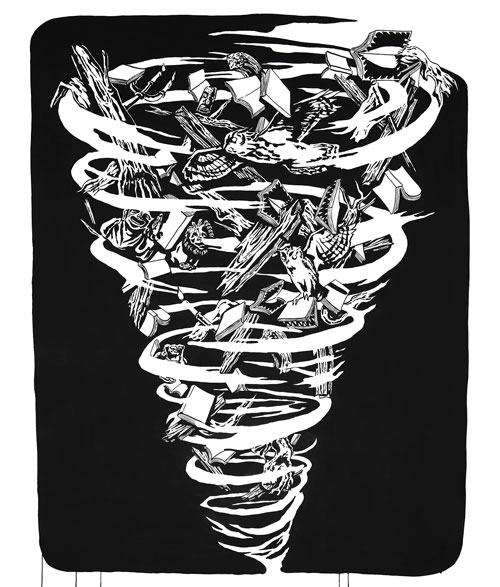
Jeongsu Woo, Floating shadows, 2016 ©OCI Museum of Art
Meanwhile, between 2010 and 2012, Jeongsu
Woo created the ‘Grave of Books’ series, consisting of over 110 drawings that
skeptically depict human greed and the absurdities it engenders. His 2016 solo
exhibition, 《Grave of Books》,
at the OCI Museum of Art expanded upon this series, transforming the entire
exhibition into a large-scale drawing and narrative experience.
Once again, Woo treated the exhibition
space as a narrative stage, allowing his images to interconnect. At the
entrance, he prominently featured a drawing of an owl—symbolizing the
observer—to establish his perspective as an artist. Meanwhile, the large-scale
mural covering the walls captured the chaotic flow of the world, juxtaposed
with the artist’s gaze as he critically examines it.
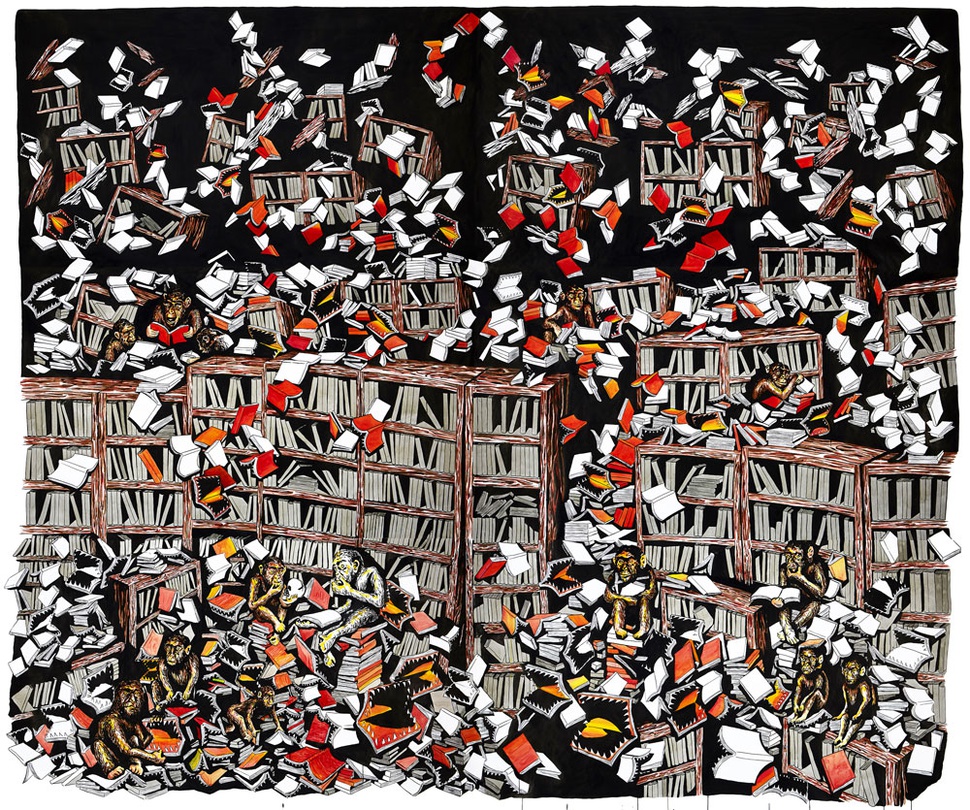 Jeongsu Woo, Monkey
library, 2015 ©OCI Museum of Art
Jeongsu Woo, Monkey
library, 2015 ©OCI Museum of ArtThe large-scale painting Monkey library
(2015), measuring 5×5 meters, depicts books neatly arranged on shelves while
simultaneously portraying a state of chaos, with books falling and floating in
disarray. Amid this scene, monkeys dominate the space, stacked together yet
seemingly mocking the turbulence of human civilization.
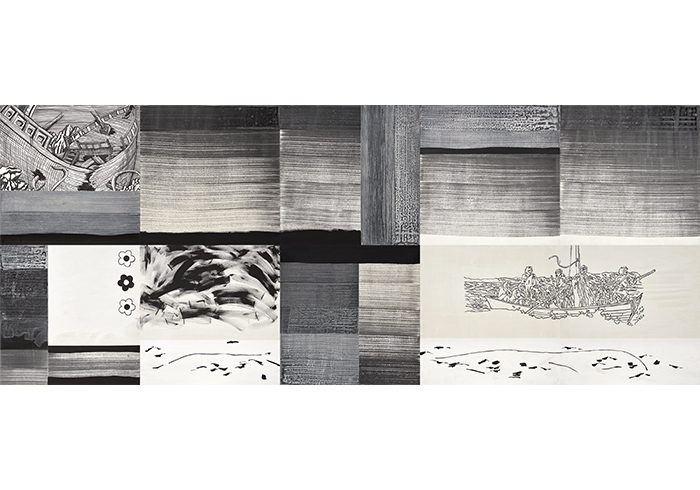
Jeongsu Woo, Calm the storm 1-2, 2017 ©Kumho Museum of Art
The ‘Calm the storm’ series, presented in
2018, introduces a different narrative structure from Jeongsu Woo’s previous
works. Inspired by the biblical miracle of “Jesus Calms the Storm”, Woo does
not explicitly depict its traditional iconography or storyline. Instead, he
erases its religious connotations, allowing imagery and narrative to be freely
deconstructed and layered.
This work consists of multiple large
canvases combined, where some sections feature detailed depictions that
construct a narrative, while others break apart and fragment, overlapping with
painterly expressions. Abstract symbols, repetitive lines and patterns, and
bold graphic elements are emphasized, yet they repeatedly return to and diverge
from the storyline, fluidly navigating between image and narrative.
Whereas Woo’s earlier works closely adhered
to storytelling, ‘Calm the storm’ introduces gaps between image and narrative,
allowing the painting to exist beyond the confines of a structured story.
 Jeongsu Woo, Brighter
tomorrow, 2019 ©Jeongsu Woo
Jeongsu Woo, Brighter
tomorrow, 2019 ©Jeongsu WooIn this way, Jeongsu Woo has continuously
recontextualized existing iconography and narratives through black-and-white
line drawings, creating new stories or spaces that allow for multiple
interpretations. Beginning in 2018, he expanded his practice by incorporating a
broader range of colors.
His 2019 series, ‘Compulsion to Repeat’,
retains the illustrative quality of his earlier drawings while integrating
repetitive lines, patterns, and vibrant colors. This series draws motifs from
classical literature and biblical stories—such as Jonah,
Moby-Dick, and The Odyssey—to explore the
theme of modern-day "compulsion."
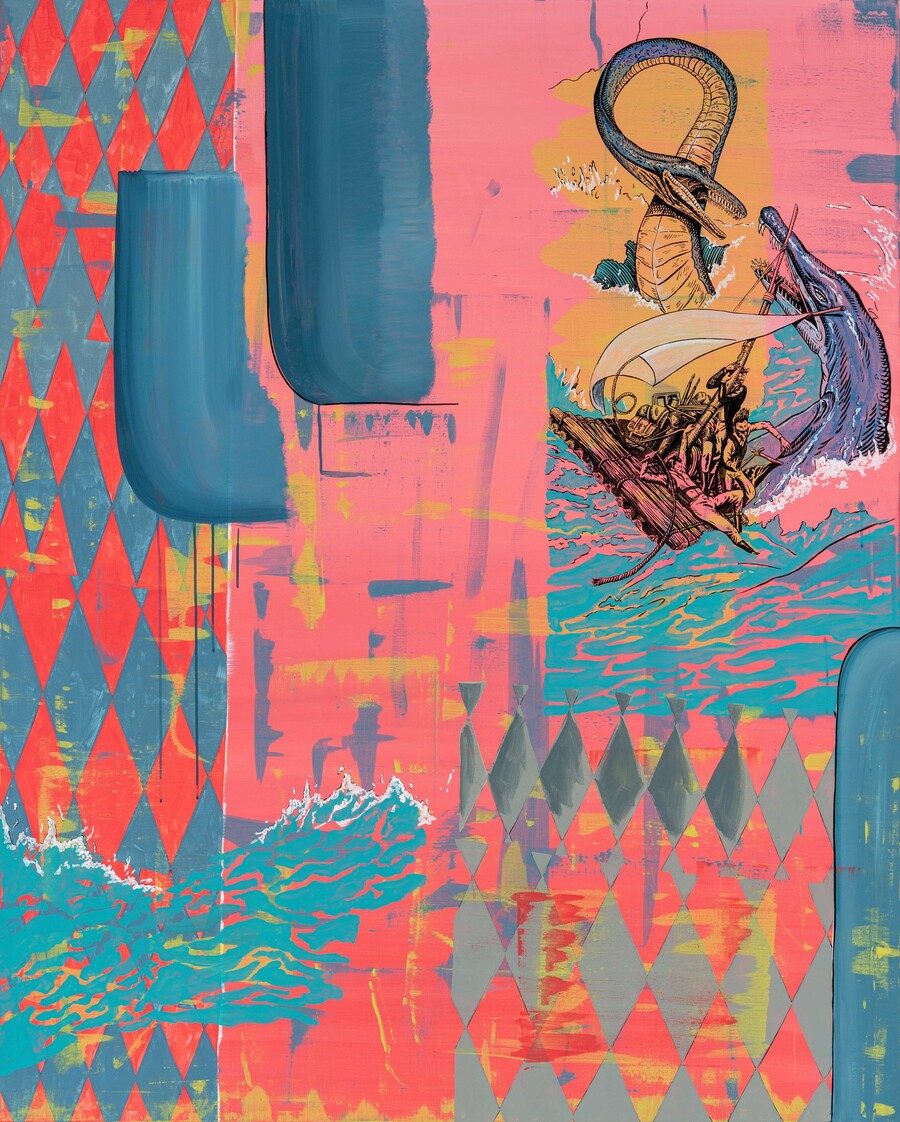 Jeongsu Woo, Young
painters, 2019 ©Jeongsu Woo
Jeongsu Woo, Young
painters, 2019 ©Jeongsu WooIn this work, Jeongsu Woo further disrupts
the typical relationship between image and narrative by transforming existing
iconography or inserting meaningless patterns and still lifes between them. In
his practice, symbols with various meanings are consumed like patterns,
detached from their context and original source. This allows them to be
reinterpreted within the “here and now” context the artist wishes to
explore.
The patterns in his paintings are derived
from sources such as set designs of wealthy homes, wallpaper from cafés or
salons, and clothing seen in media during the economic boom of the early 1990s.
These references metaphorically expose the "obsession with wealth," a
modern-day form of compulsion, while continually invoking the past economic
prosperity and the excessive fantasy surrounding it. Through this, Woo
critiques the "newtro" culture—the contemporary obsession with
nostalgia—highlighting it as another form of modern obsession.
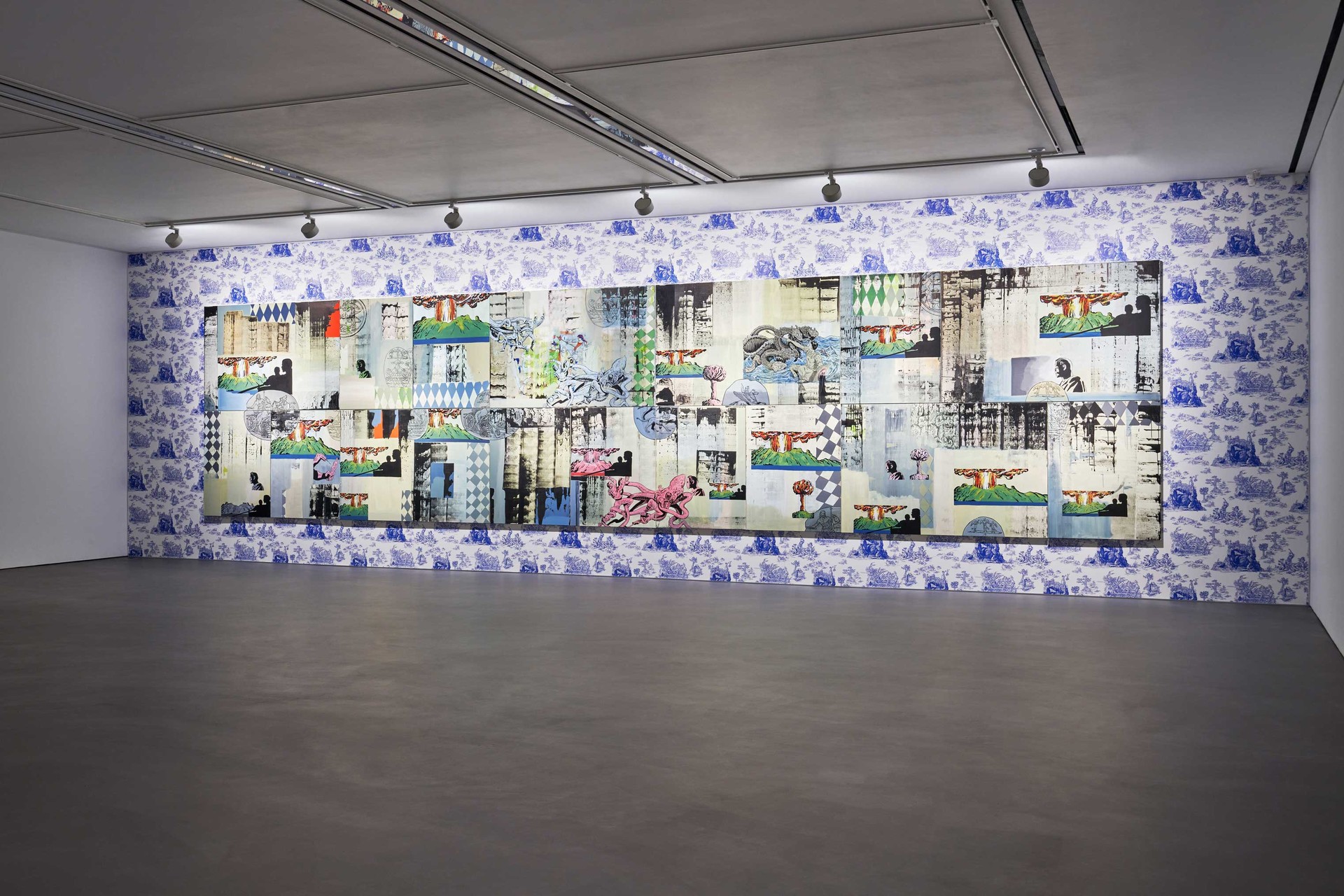 Installation view
of 《Where Is My Voice》 (DOOSAN Gallery, 2020) ©Jeongsu
Woo
Installation view
of 《Where Is My Voice》 (DOOSAN Gallery, 2020) ©Jeongsu
WooIn his 2020 solo exhibition 《Where Is My Voice》 at DOOSAN Gallery,
Jeongsu Woo presented the large-scale work Where Is My Voice
(2020), composed of 16 canvases. This piece fragmentarily incorporates motifs
from the myths of ‘Echo’ and the ‘Sirens’, exploring the concept of "voice"
through his painterly language.
Within this work, mythological scenes
appear but are repeatedly disrupted by ink-rolled surfaces and rhombus
patterns, creating gaps and fractures in the otherwise solid structure of
classical narratives. A recurring volcano and male figure—sourced from Disney’s
1954 comic adaptation of 20,000 Leagues Under the Sea—float
across the canvas, stripped of their original context. By dismantling these
elements, Woo destabilizes fixed narratives, allowing new interpretations and
possibilities to emerge.
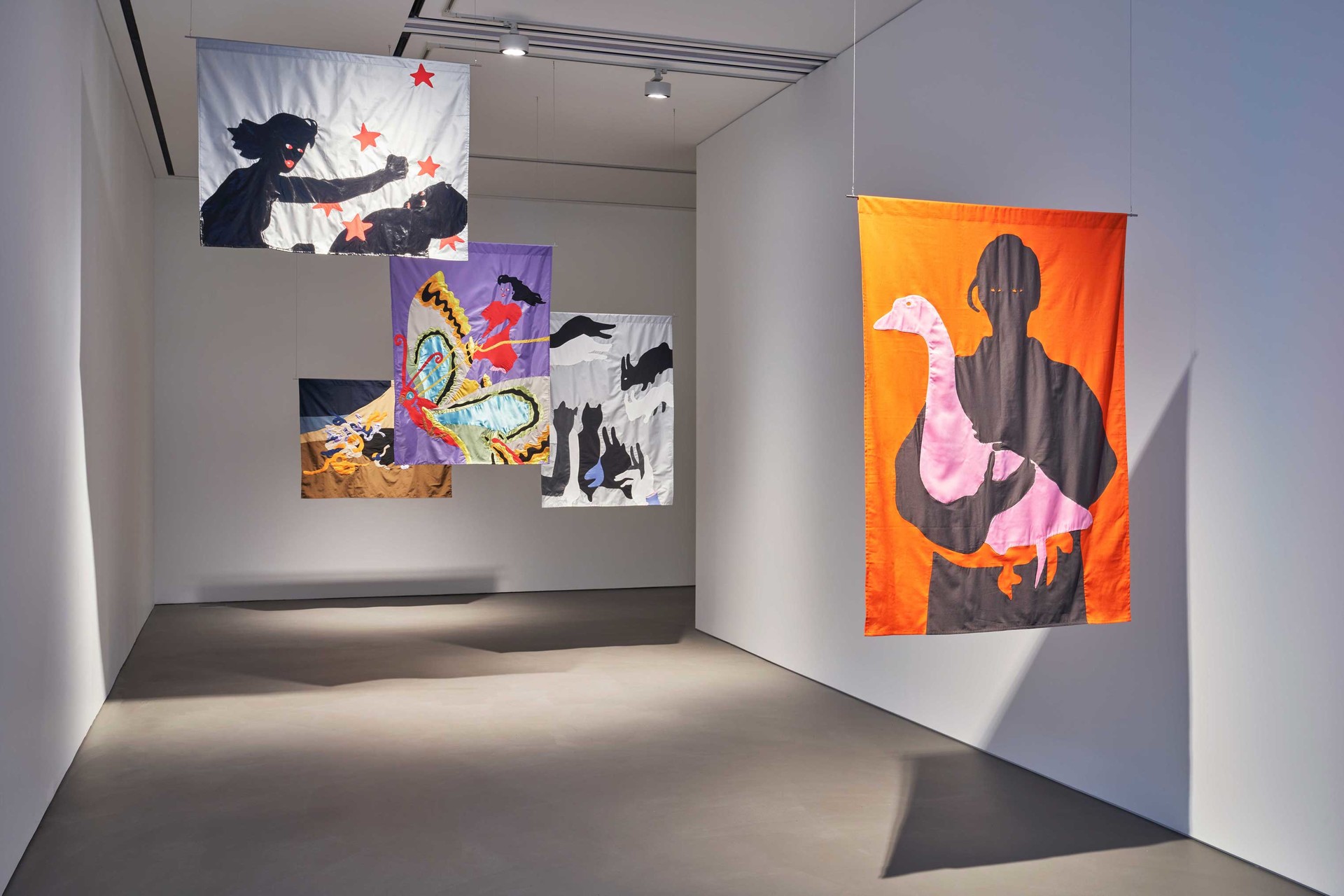 Installation view
of 《Where Is My Voice》 (DOOSAN Gallery, 2020) ©Jeongsu
Woo
Installation view
of 《Where Is My Voice》 (DOOSAN Gallery, 2020) ©Jeongsu
WooThe fragmented icons disconnected from
logical narratives exist in isolation, creating empty spaces within the
composition. Curator Junghyun Kwon interpreted this approach as a way to
reflect "a society governed not by clear causality and rationality, but by
disorder and irrationality."
Additionally, in his exhibition at DOOSAN
Gallery, Jeongsu Woo incorporated fabric as a medium for the first time. The
image of the painting is transferred onto fabric patterns, and through the
seams created by stitching the surfaces together, the artist’s pictorial grammar
of deconstructing and reweaving narratives and icons from various eras is
revealed in a more performative manner.
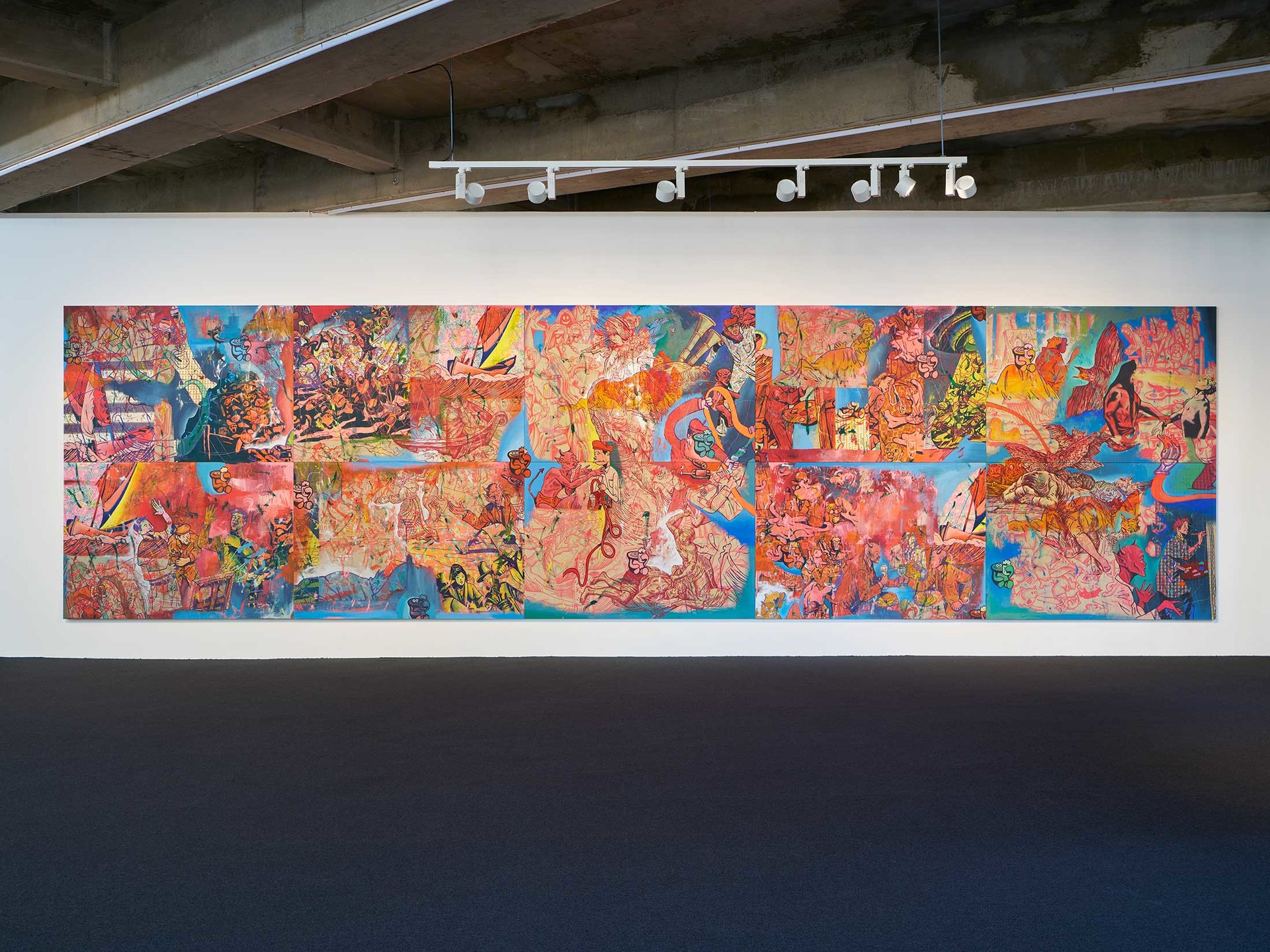 Installation view
of 《Three Devils by the Bedside》 (Art Sonje
Center, 2024) ©Jeongsu Woo
Installation view
of 《Three Devils by the Bedside》 (Art Sonje
Center, 2024) ©Jeongsu WooThe ‘Three Devils by the Bedside’
(2023-2024) series, presented in his solo exhibition at Art Sonje Center in
2024, originates from the artist's personal struggle with insomnia. Insomnia is
not only an individual issue but also a social problem faced by many
contemporary Koreans, stemming from anxiety, depression, stress, and
trauma.
Rather than simply suffering from insomnia
and depression, the artist chose to explore and examine these issues, delving
into various literature and visual materials. Through this process, he
discovered a story from medieval Europe, where a knight suffered from insomnia
due to "three devils by the bedside" for many years, only to be
miraculously healed after meeting a monk at Canterbury Cathedral. This
discovery inspired the concept for this work.
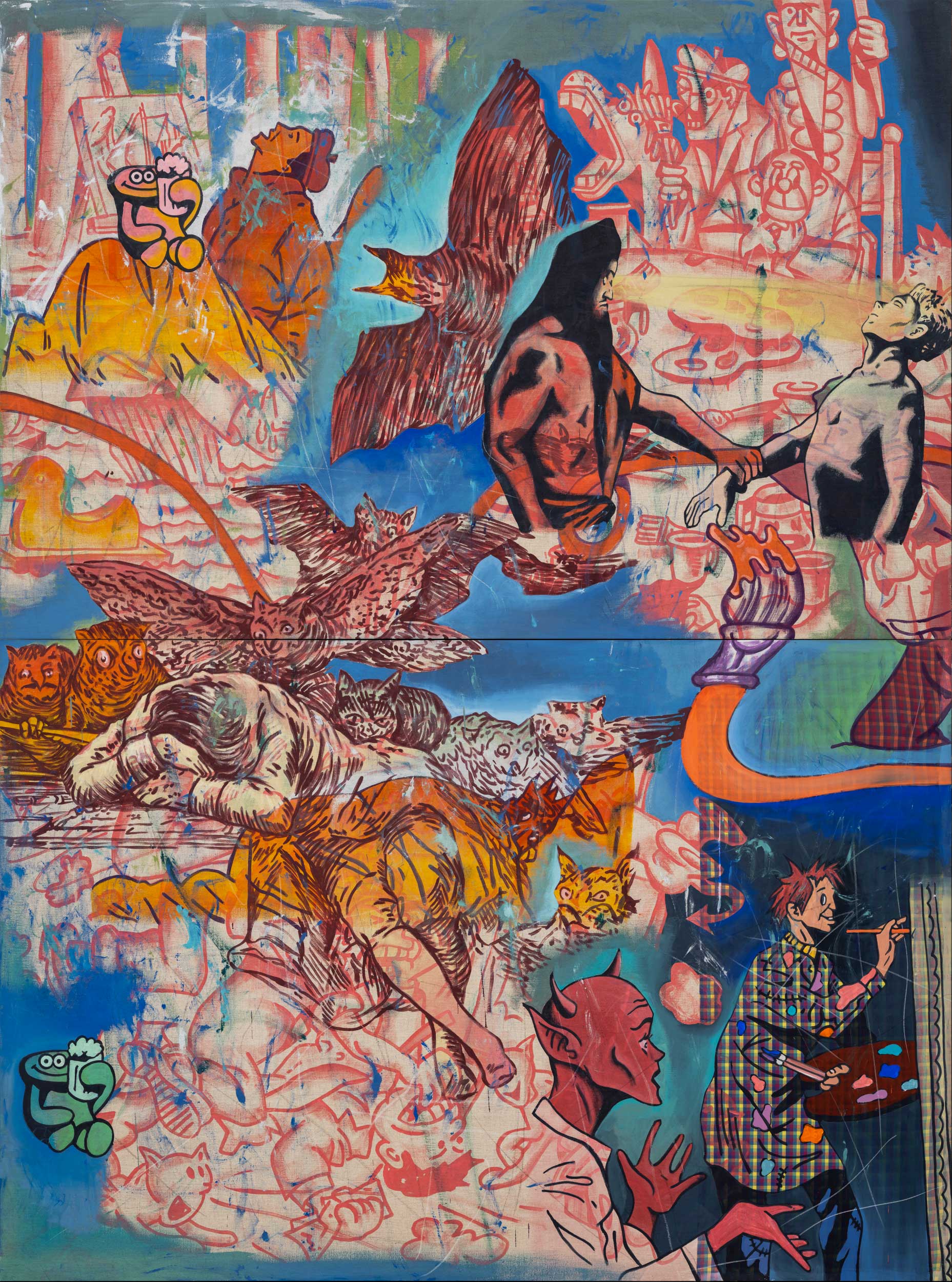 Jeongsu Woo, Three
Devils by the Bedside #5, 2024 ©Jeongsu Woo
Jeongsu Woo, Three
Devils by the Bedside #5, 2024 ©Jeongsu Woo‘Three Devils by the Bedside’ presents
fragmented sequences of a story, much like the dreams experienced during
sleepless nights. Ten canvases are arranged in two rows to form one large
composition, but each canvas frame divides the screen according to the artist's
arbitrary arrangement.
In this layered screen composition, the
artist repeatedly features his persona, "Mr. Painter." Within the
overlapping imagery, Mr. Painter can be seen working hard at painting, meeting
people in pursuit of success, experiencing failure, and, at a moment of crisis,
being tempted by the devils. These fragmented scenes unfold as part of the
narrative.
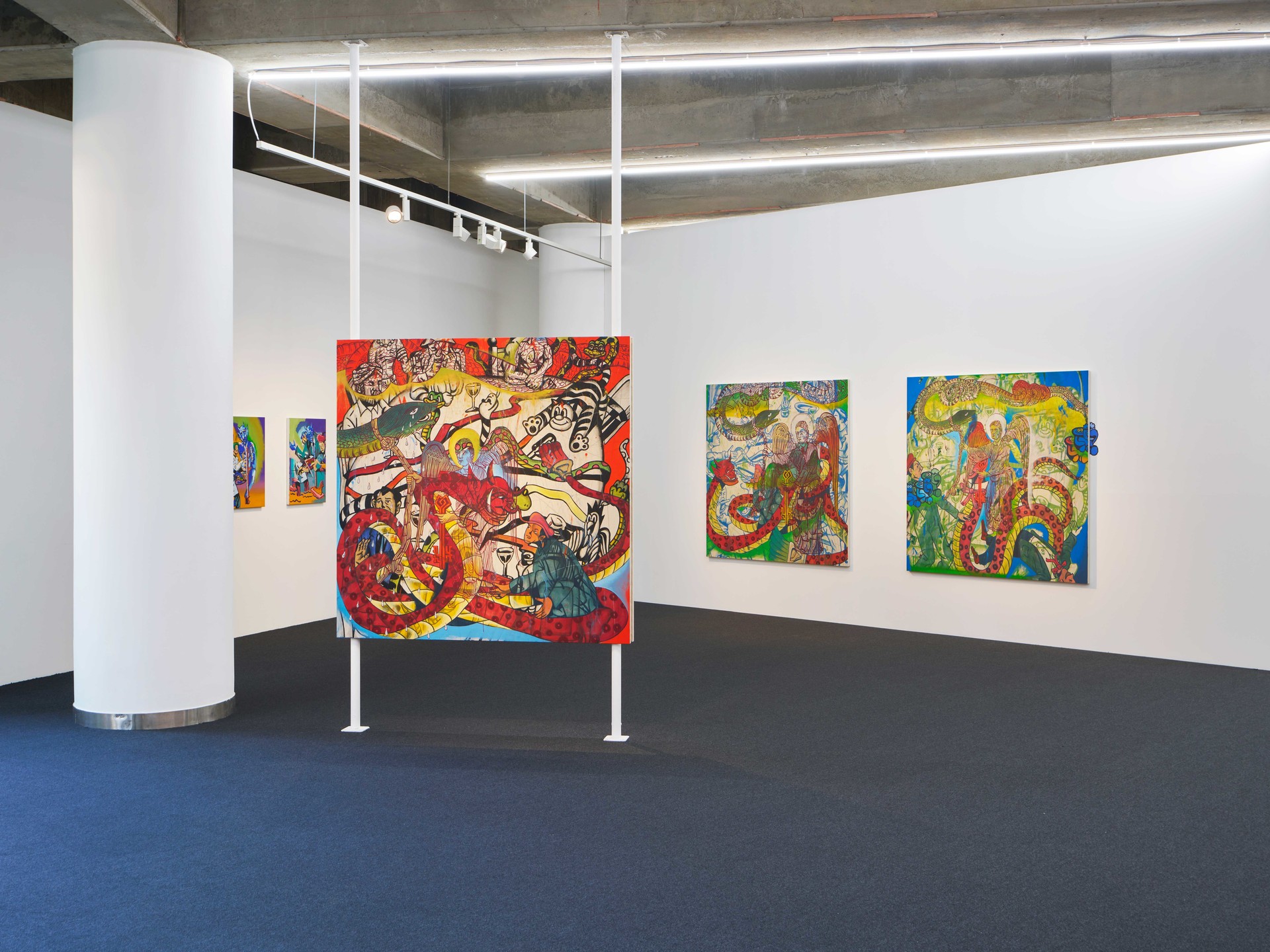 Installation view
of 《Three Devils by the Bedside》 (Art Sonje
Center, 2024) ©Jeongsu Woo
Installation view
of 《Three Devils by the Bedside》 (Art Sonje
Center, 2024) ©Jeongsu WooAs Mr. Painter's life unfolds, the figures
of demons, illustrations from Goethe's Faust, scenes from
Goya's Black Paintings, and cartoon characters are scattered across the canvas,
creating an effect where the story within the image seems to unfold infinitely.
This arrangement brings to life the demonic cycle of desires, failures,
frustrations, and victories, continuously repeating in the artwork.
Woo states, “It’s interesting how connected
lines can become images and stories,” and describes his work as “paintings that
originate in lines.” In his art, various symbols and narratives coexist through
the free flow of lines, weaving into new contexts and alternative stories. His
paintings stay true to the allegorical function of painting while expressing a
cynical satire of contemporary socio-cultural phenomena.
"When I draw, I see a painting as a play. It
can resemble Theatre of the Absurd, satire, or black comedy, depending on the
situation. The canvas becomes a stage, I become the director, and my drawings
become the actors." (Jeongsu Woo, Art Sonje Center Interview, 2024)
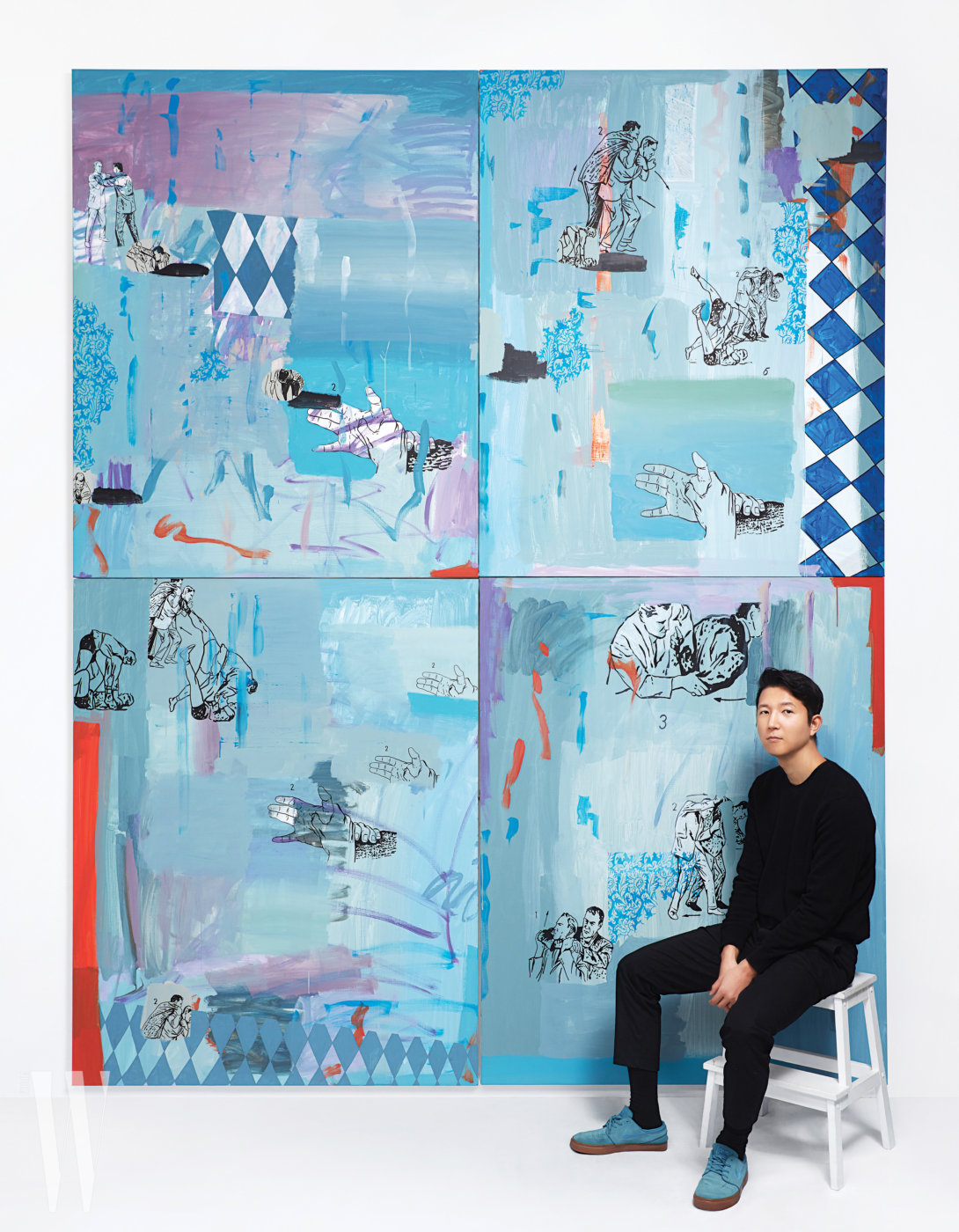 Artist Jeongsu Woo
©W Concept
Artist Jeongsu Woo
©W ConceptJeongsu Woo received a B.F.A and an M.F.A
in Fine Arts from Korea National University of Arts. Woo’s significant solo
exhibitions include 《Three Devils by the Bedside》
(Art Sonje Center, 2024), 《Palindrome》 (BB&M, 2022), 《Where Is My Voice》 (DOOSAN Gallery Seoul, 2020), 《Tit for Tat》 (DOOSAN Gallery New York, 2020), and 《Calm
the Storm》 (Kumho Museum of Art, 2018).
He has also been featured in numerous local
and international group exhibitions, such as 《Cadenza》
(Korean Cultural Center in Hong Kong, 2024), 《Flowing Moon, Embracing Land》 (Jeju
Biennale, 2022), 《Young Korean Artists 2021》 (National Museum of Modern and Contemporary Art, Korea, Gwacheon,
2021), 《Fortune Telling》 (Ilmin
Museum of Art, 2021), 《Compulsion to Repeat》 (Seoul Museum of Art, 2019), and 《Imagined
Borders》 (Gwangju Biennale, 2018).
Woo participated in MMCA Goyang Residency
in 2017 and DOOSAN Residency New York in 2020. His works are currently housed
in the collections of DOOSAN Art Center, OCI Museum of Art, Kumho Museum of
Art, MMCA, Blackstone Group, and more.
References
- 우정수, Jeongsu Woo (Artist Website)
- 황정인, 미답지의 산책자 (Jay Jungin Hwang, Flaneur in the Uncharted Territory)
- 프로젝트 스페이스 사루비아, 불한당의 그림들 (Project Space Sarubia, Painting of Villian)
- OCI 미술관, 책의 무덤 (OCI Museum of Art, Grave of Books)
- 금호미술관, Calm the storm (Kumho Museum of Art, Calm the storm)
- 올댓아트, 현대인의 ‘심리적 강박’을 마주하게 되는 전시, 2019.12.04
- 서울시립미술관, 강박² (Seoul Museum of Art, Compulsion to Repeat)
- 두산아트센터, Where Is My Voice (DOOSAN Gallery, Where Is My Voice)
- 권정현, 이야기를 찾아 떠나는 항해 – 우정수 개인전《Where Is My Voice》
- 아트선재센터, 우정수: 머리맡에 세 악마 (Art Sonje Center, Jeongsu Woo: Three Devils by the Bedside)



